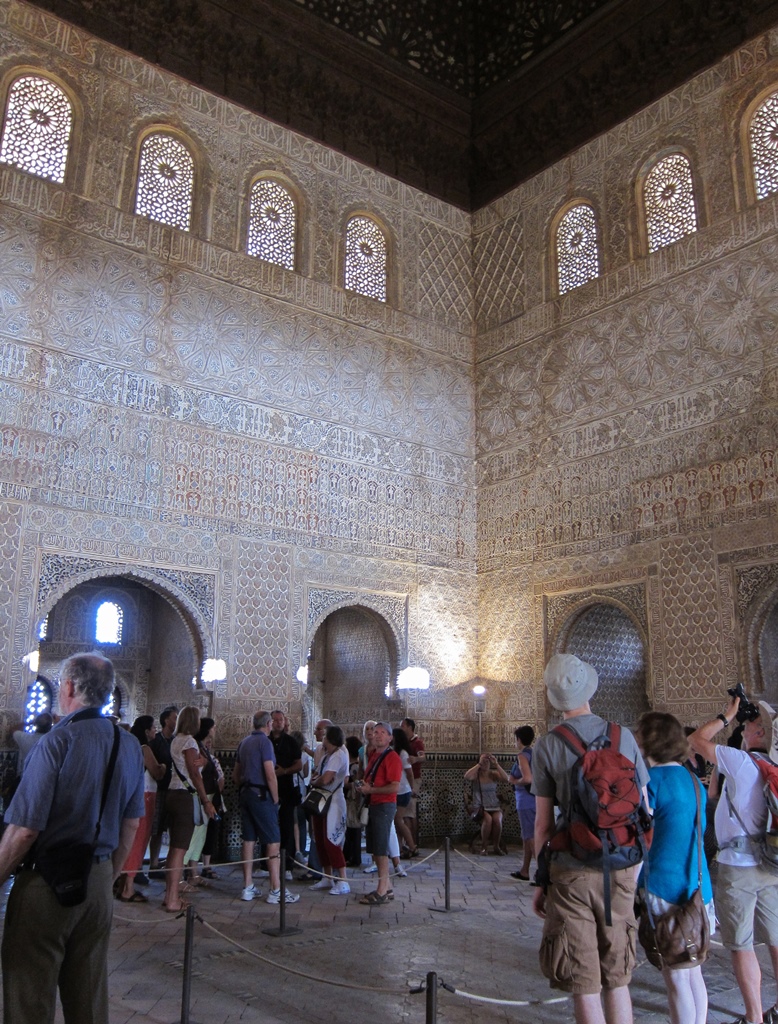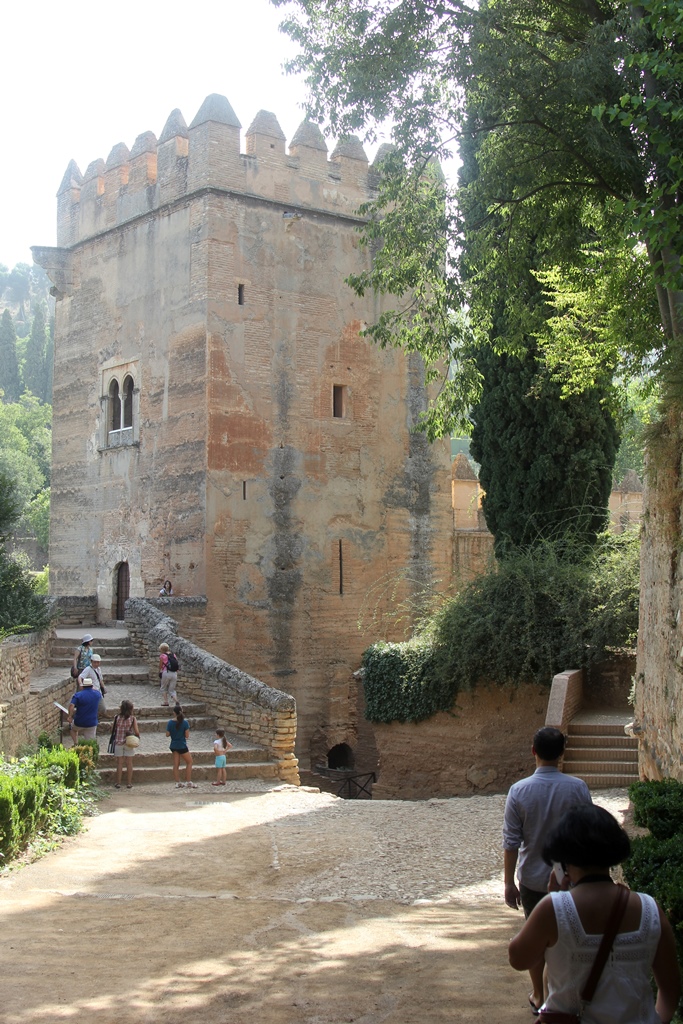We started the following day by visiting the Alhambra. Followers of this site will be
aware that we'd done this before, with two pages devoted to it
here and
here. I'll
try not to repeat too much of what appeared in those pages, but will review a few points for the
benefit of new visitors. First, the palace/fortification complex known as the Alhambra was built
in the 13th and 14th Centuries by rulers from the Moorish Nasrid dynasty, who controlled Granada
at the time. By the 15th Century, Granada was the last remaining Moorish emirate on the Iberian
Peninsula, all of the others having fallen to Christian armies in the course of a multi-century
campaign known as the Reconquista. Granada maintained an uneasy coexistence with the
surrounding Christian kingdoms for several decades, but this all came to an end early in 1492,
when Granada was surrendered to the overwhelming Christian forces of King Ferdinand and Queen
Isabella. The Moorish sultan, known as Boabdil, was allowed to depart peaceably, along with his
family and immediate followers, leaving the Alhambra intact for the enjoyment of the Catholic
Monarchs, and eventually of swarms of tourists armored in Polo shirts and wielding smartphones and
digital SLRs.
The adventures of Ferdinand and Isabella have been discussed at some length elsewhere, but a few
more words about Boabdil may be in order. The name "Boabdil" was not a real name, but an attempt
by Spaniards to turn the real name, something more like Abu Abdullah, into something they
could pronounce. Boabdil, who was born in the Alhambra around 1460, became sultan in 1482 by
ousting his father, Abu I-Hasan Ali, from the throne. At this time he took the name Muhammad XII,
and attempted to gain prestige and cement his role as ruler by going off to fight the Christians
(his father had already initiated some ill-advised hostilities). This didn't work out according
to plan, as he was promptly captured by the Christians at Lucena in 1483. Abu I-Hasan Ali
resumed the throne briefly before abdicating in favor of his brother, Sa'd al-Zaghal, in 1485, and
dying in the same year. Sa'd al-Zaghal took the name Muhammad XIII, but XIII would not be a lucky
number for him, as Boabdil returned, with Christian support, in 1487. Boabdil had promised that
he would hold Granada as a tributary kingdom under Ferdinand and Isabella, and that he would not
interfere with their military activities. At the time of Boabdil's return, his uncle Sa'd
al-Zaghal had been away, unsuccessfully attempting to relieve a siege at Málaga, and found that he
no longer had a throne when he tried to return to Granada's capital city. In the meantime, the
Christians successfully concluded their siege and went on to methodically capture the remaining
Moorish strongholds, until only the capital city remained in Moorish hands. In 1491, Boabdil was
summoned by Ferdinand and Isabella to discuss the official surrender of the city, which was by
then a foregone conclusion.
On leaving Granada, Boabdil and his followers travelled to an estate they had received in the
settlement, located in a mountainous area called Las Alpujarras, but they didn't stay there long.
Staying in a land that was no longer theirs must have been a painful situation, and Boabdil sent
a request for refuge to the sultan of Morocco, a request that was granted. Boabdil and retinue
crossed the Mediterranean to the city of Fes, Morocco, and spent the rest of their days there.
Boabdil eventually died in 1533.
In the absence of the Moors, the Alhambra underwent periods of remodeling, abuse, neglect and
restoration. Fortunately for us, the most recent period seems to have been one of restoration
(with maybe a little tourist abuse). Early in the morning, we set out to take stock of the
progress.
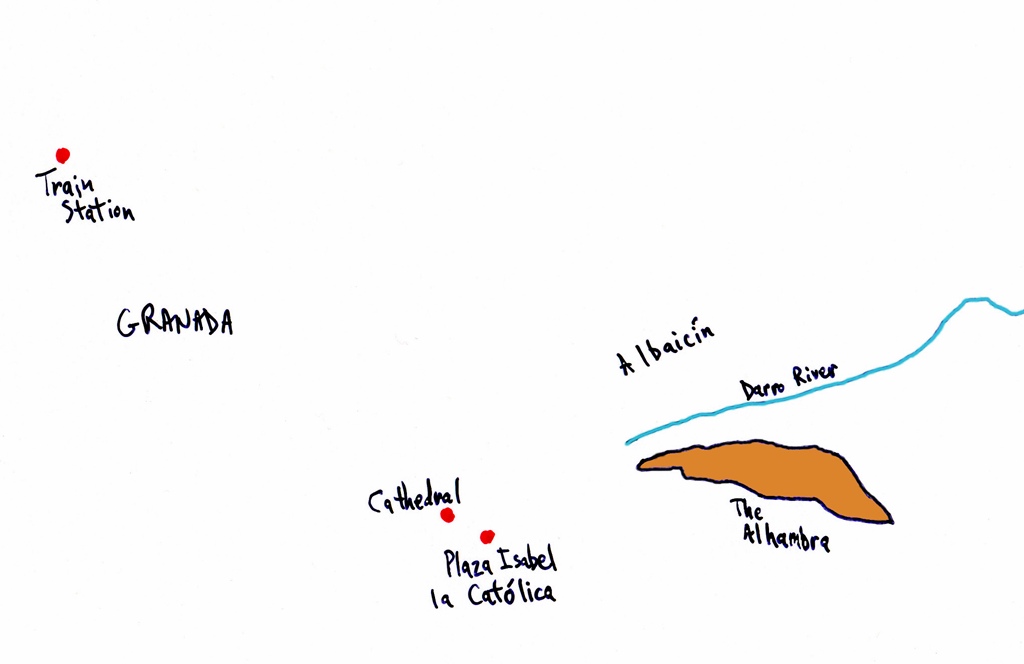
Granada
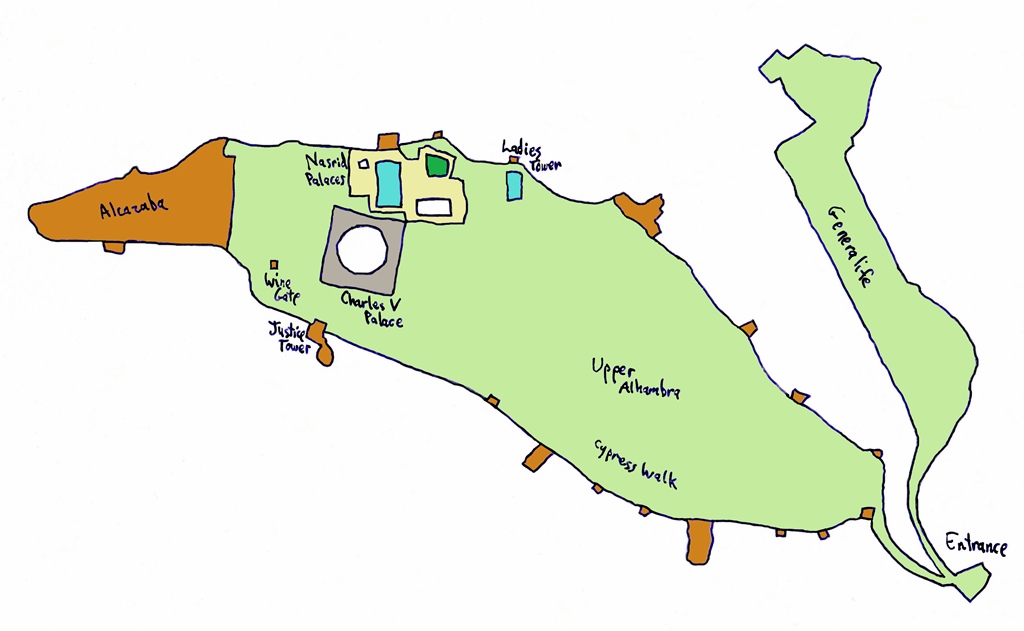
The Alhambra
As alluded to earlier, the Alhambra is on top of a hill. On our previous visit, we'd ridden
the minibus to the top, getting off at the ticket office. As this time we'd
ordered and printed our own
tickets, we didn't need to go all the way to the ticket office, but could instead use the
Justice Tower entrance, which is much closer to the Nasrid palaces. And to our hotel as it
turned out. We decided to try walking, and the trail, while on the steep side, ended up being
pleasant and pretty short. Along the way we passed a statue of Washington Irving, the
American author whose 1832 book, Tales of the Alhambra, generated worldwide interest in
the complex and led to a period of significant and much-needed restoration.
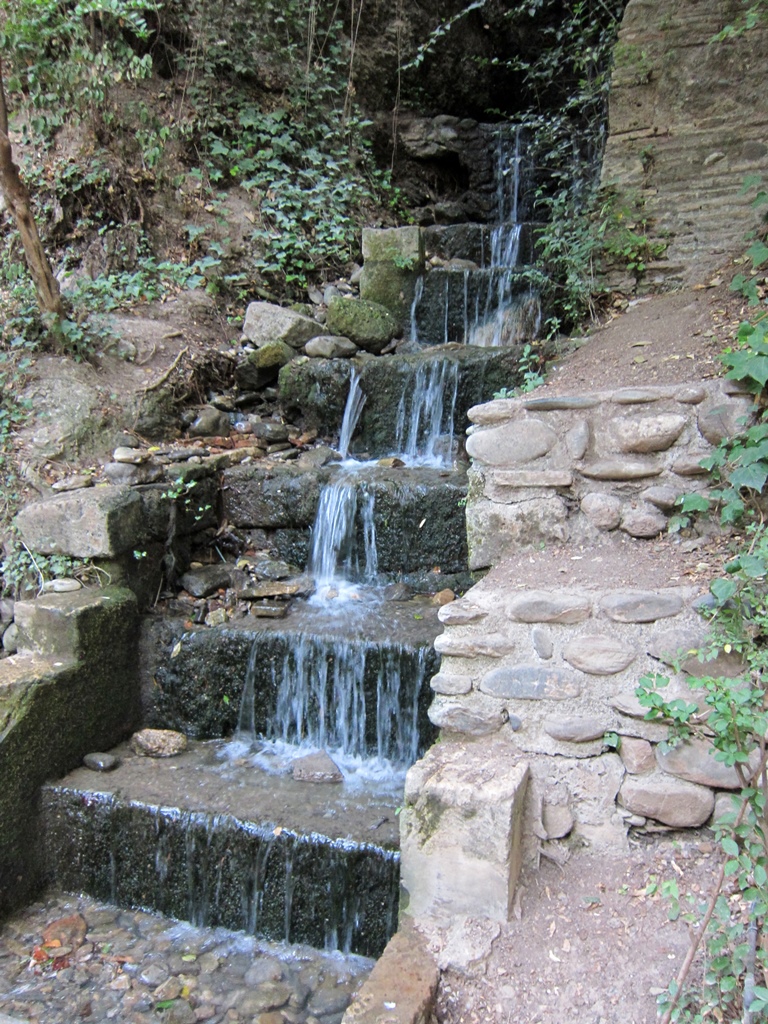
Waterfall Along Trail
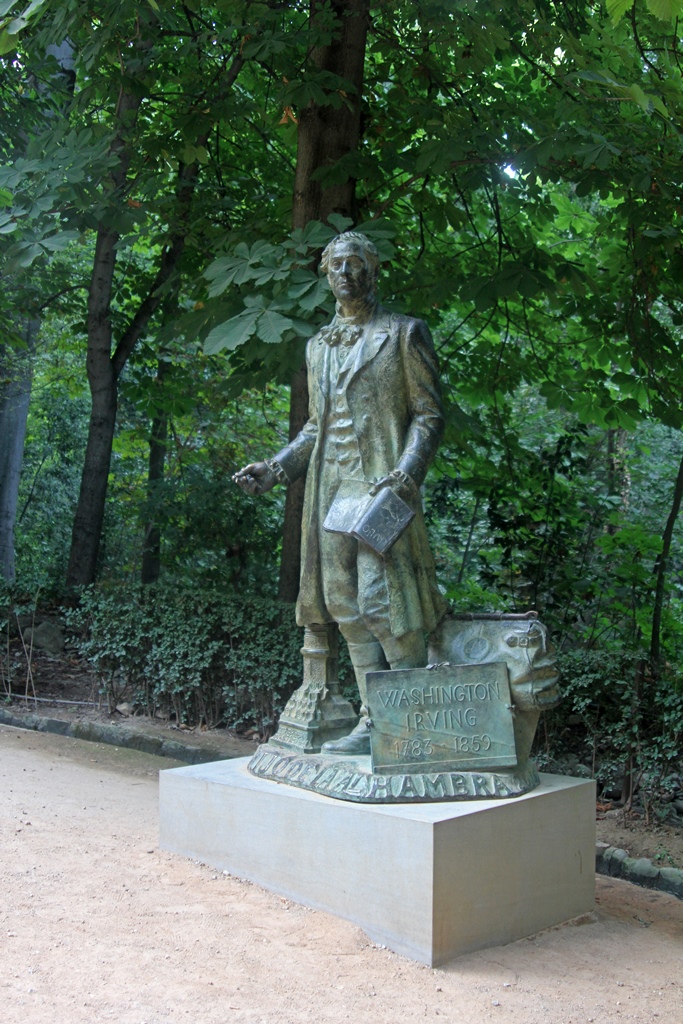
Statue of Washington Irving
Outside the Justice Gate entrance we found the Charles V Fountain, which had been added in
1543, during the reign of king/emperor Charles.
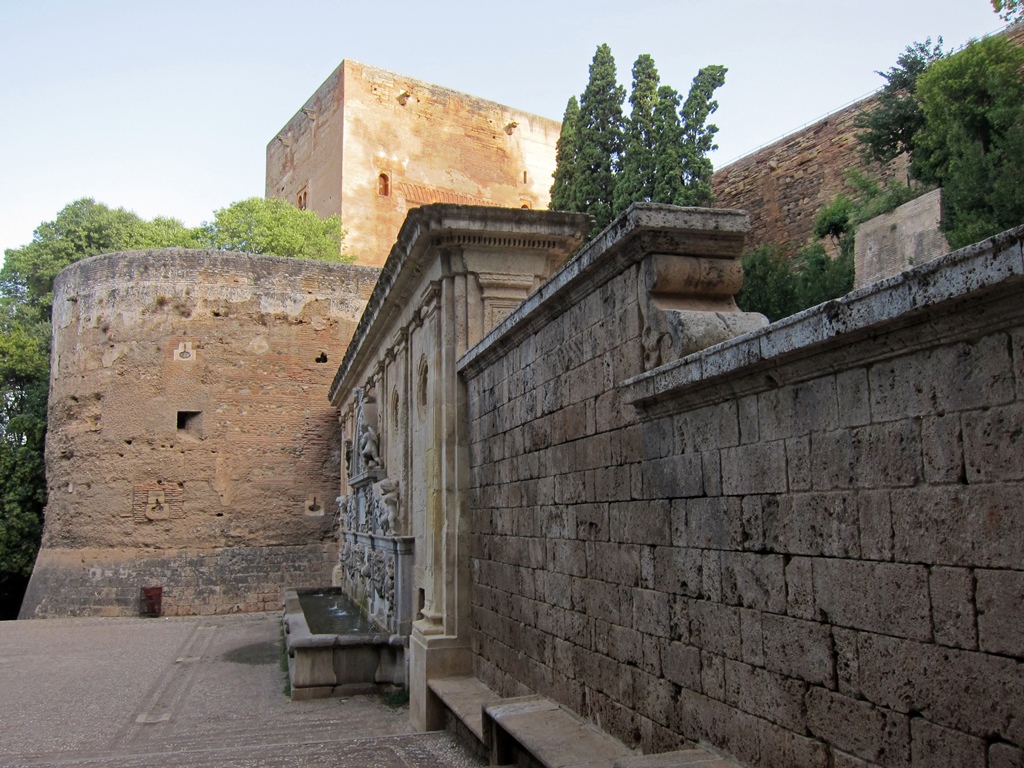
Charles V Fountain and Justice Gate
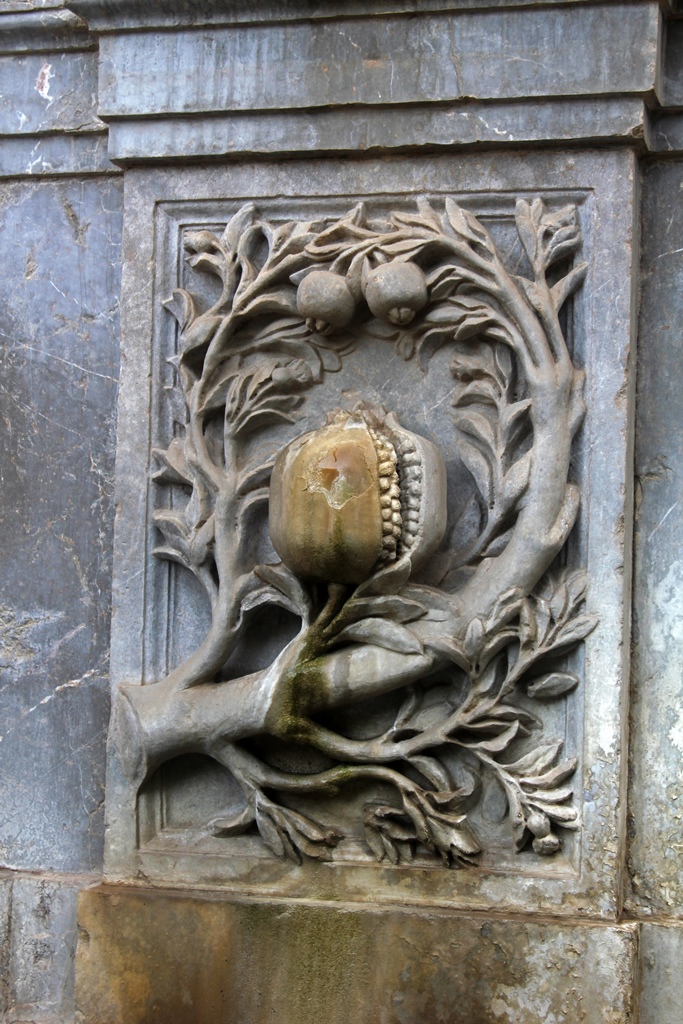
Pomegranate Detail, Charles V Fountain
With our walk having been shorter than expected, we arrived about a half hour earlier than
our appointment for the Nasrid palaces, so we looked around the Alcazaba area first. The
Alcazaba, to review, was the principal defensive fortification for the Alhambra. This being
the case, it was situated to have a good view of its surroundings. We entered the Alcazaba
area by passing through the Wine Gate.
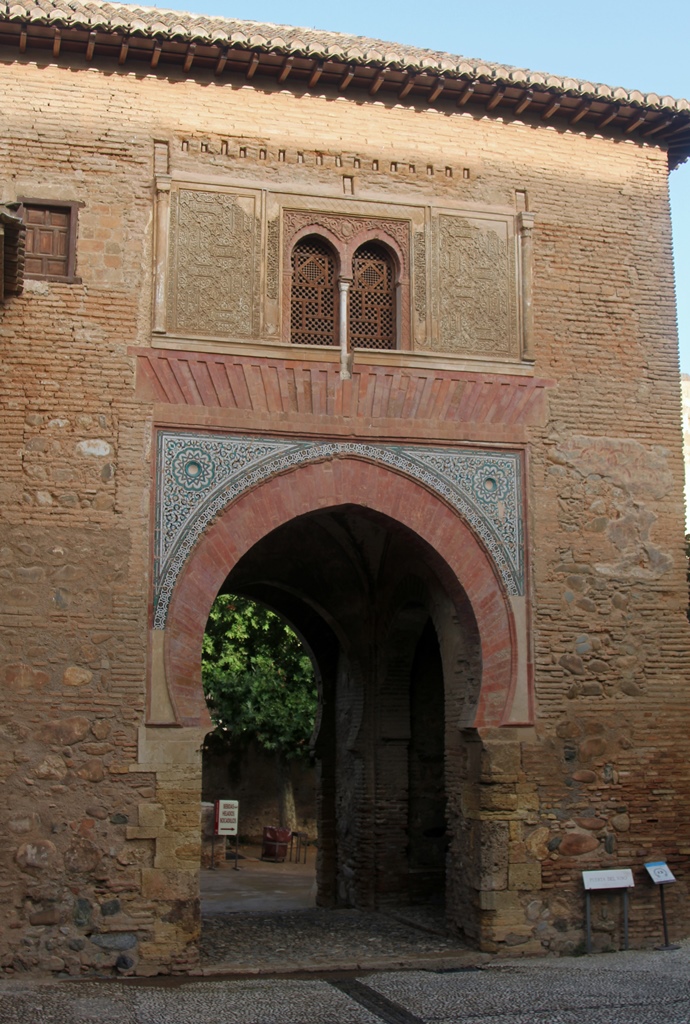
Wine Gate
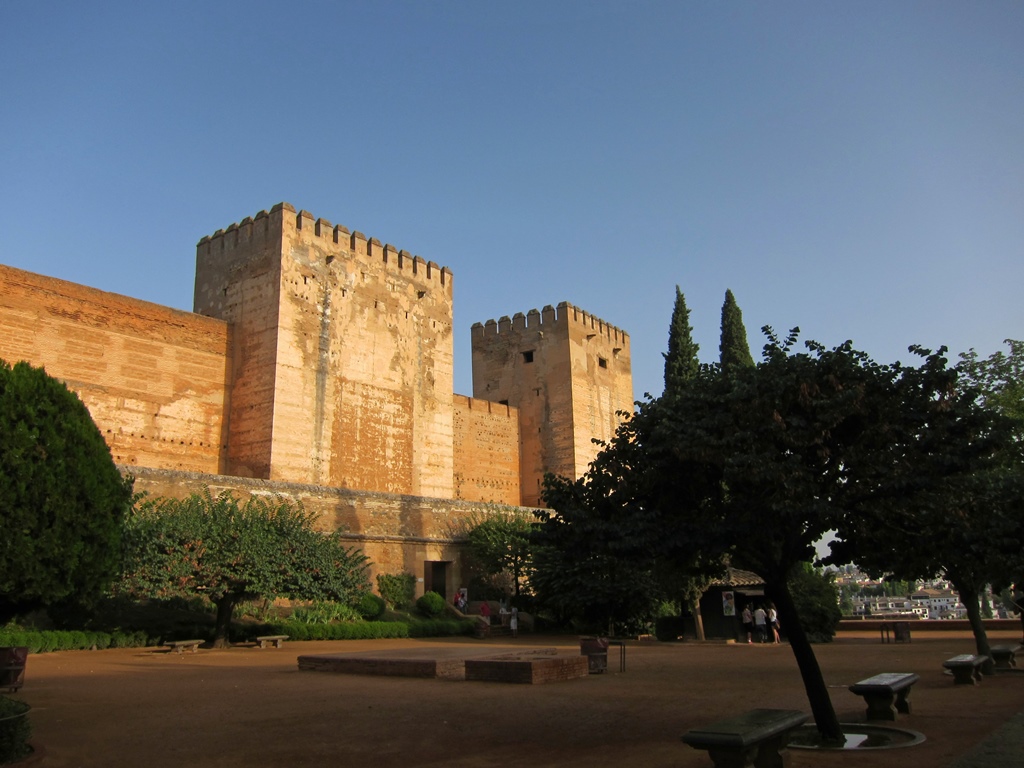
Alcazaba Entry
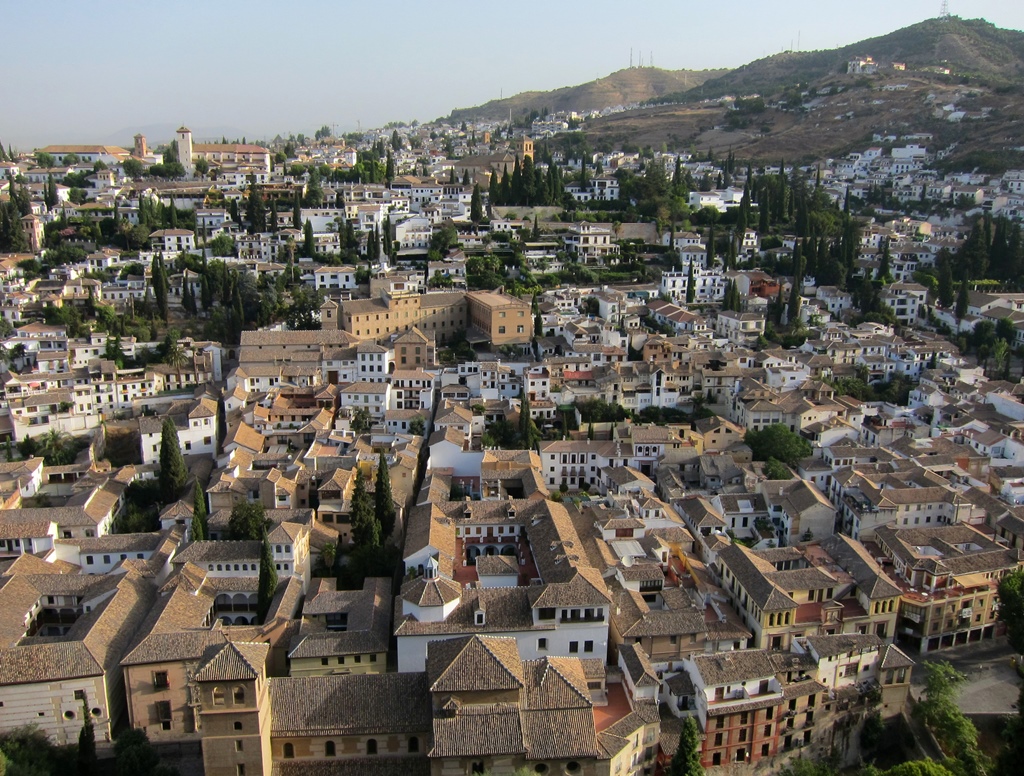
Albaicín Area from Alcazaba
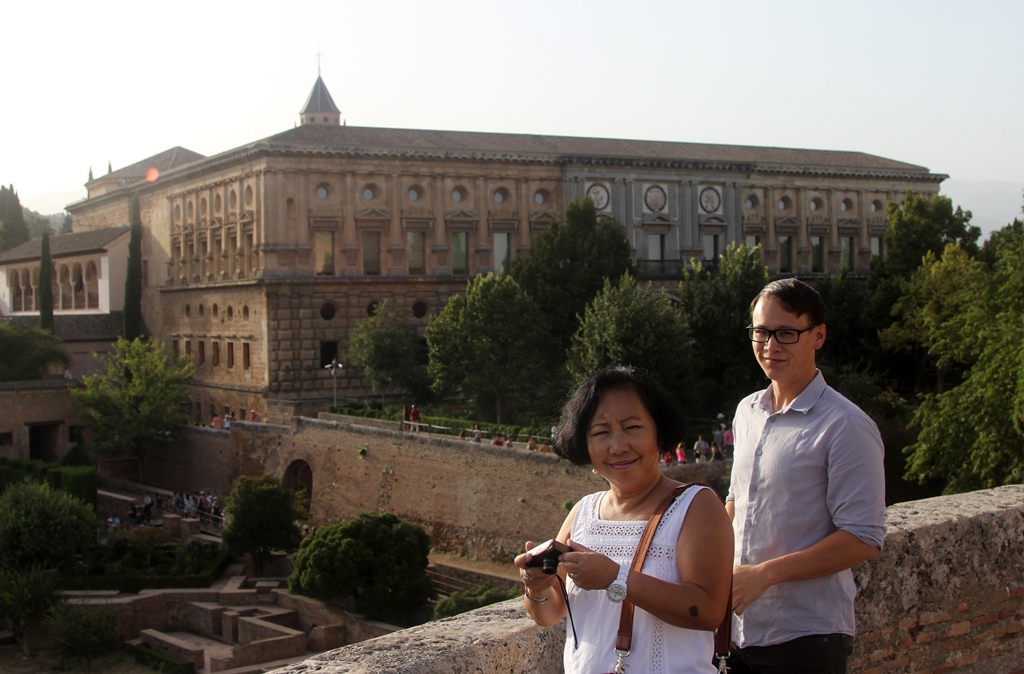
Nella and Philip and Palace of Charles V from Alcazaba
While the Alcazaba looked pretty much unchanged from our previous visit, we found that its
Watch Tower appeared to be closed to visitors. The Watch Tower is probably the spot from
which the best view can be had – there is a large bell which guards once used to raise the
alarm when invaders were detected. But even though we couldn't climb the tower, we found
a nearby spot from which we could still get a pretty good view of Granada, including its
cathedral.
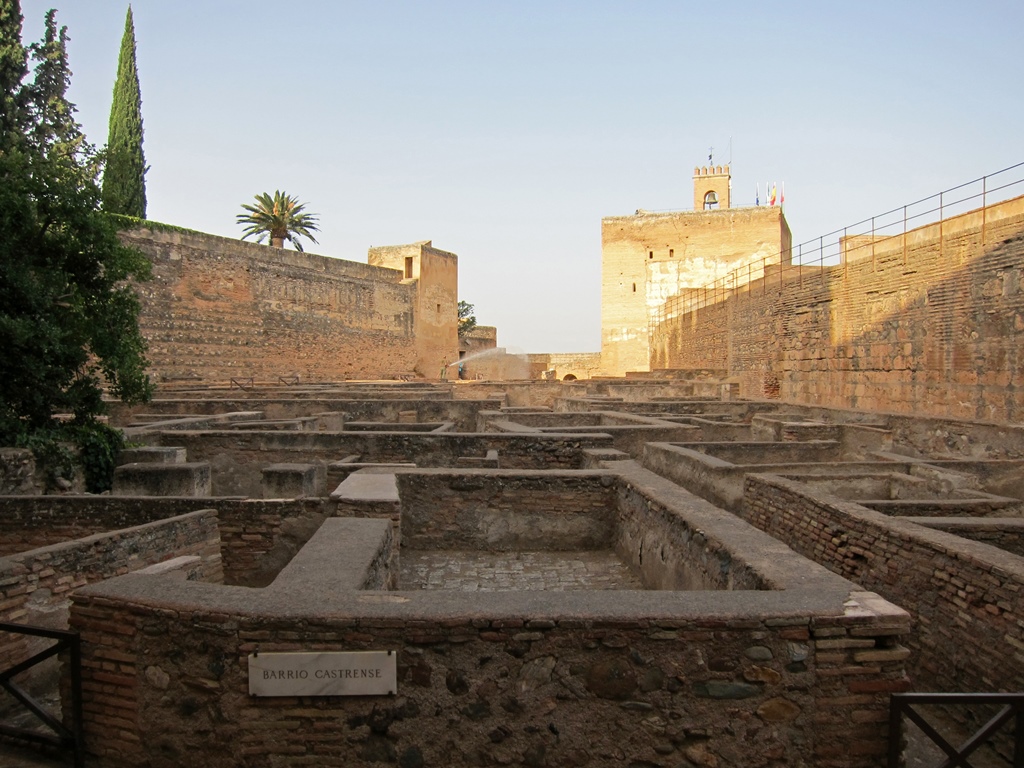
Military Area and Watch Tower, Alcazaba
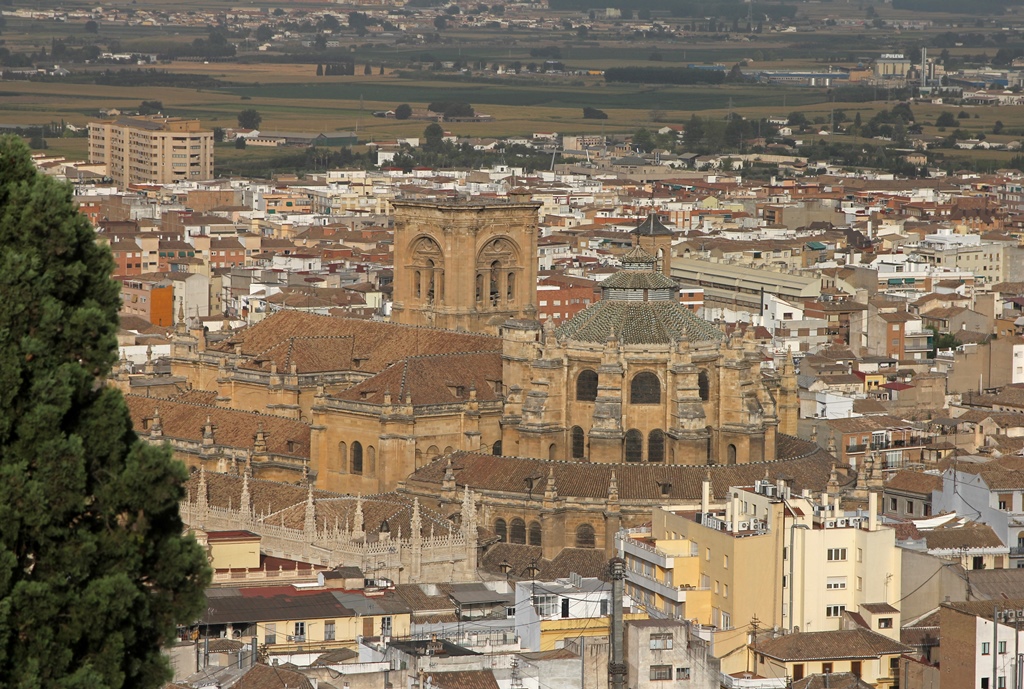
Granada Cathedral
We returned toward the Nasrid palace entrance area by walking through a garden along the
Alcazaba's south wall. We were still a few minutes early, so we paused to get our bearings.
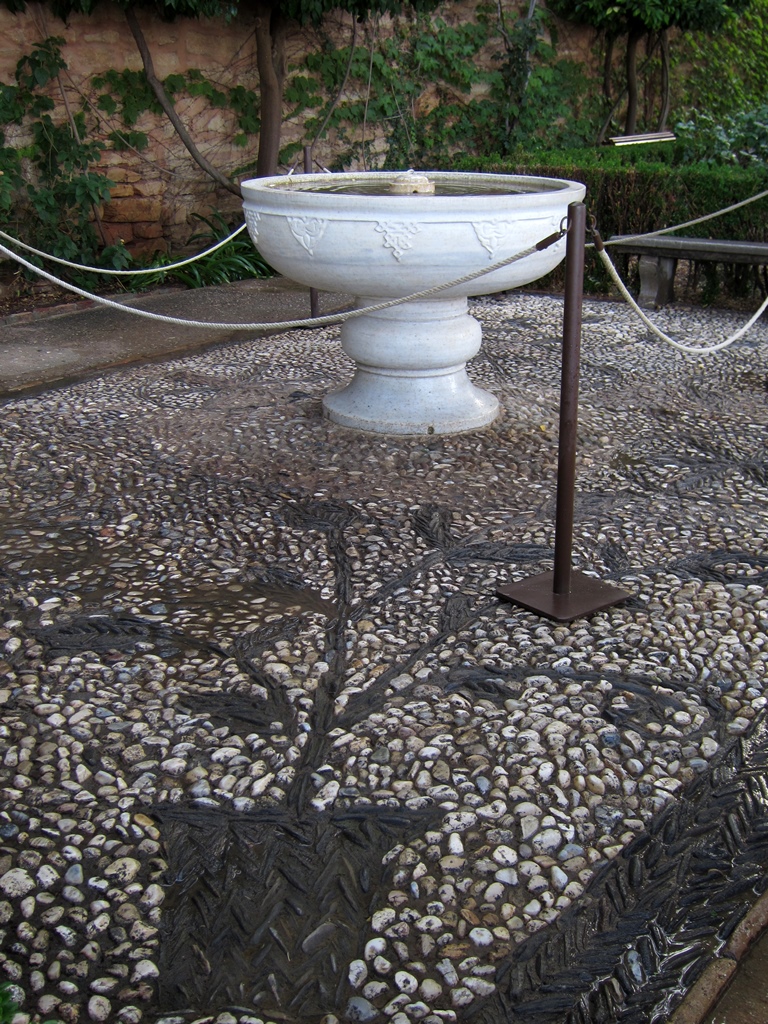
Fountain, Alcazaba Garden
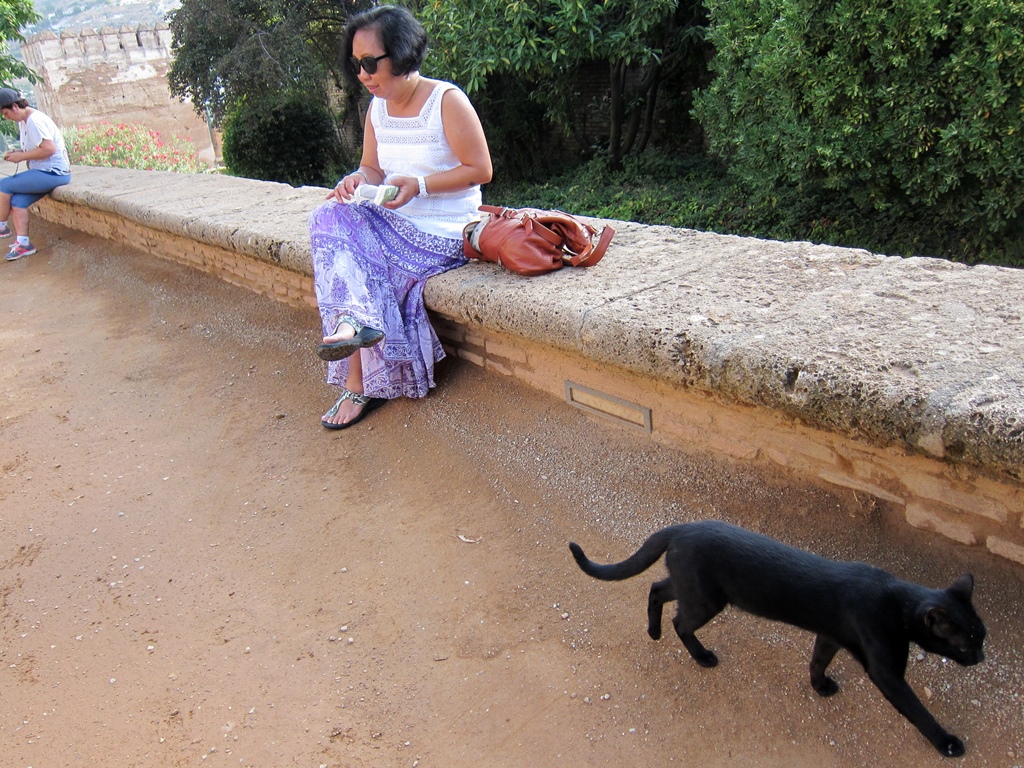
Nella and Alcazaba Cat
At the appointed time, we joined the gathered group who had tickets with the same appointed
time and were admitted to the first of the Nasrid palaces, the Mexuar Palace. This palace
is thought to have been used as a council chamber and court of justice.
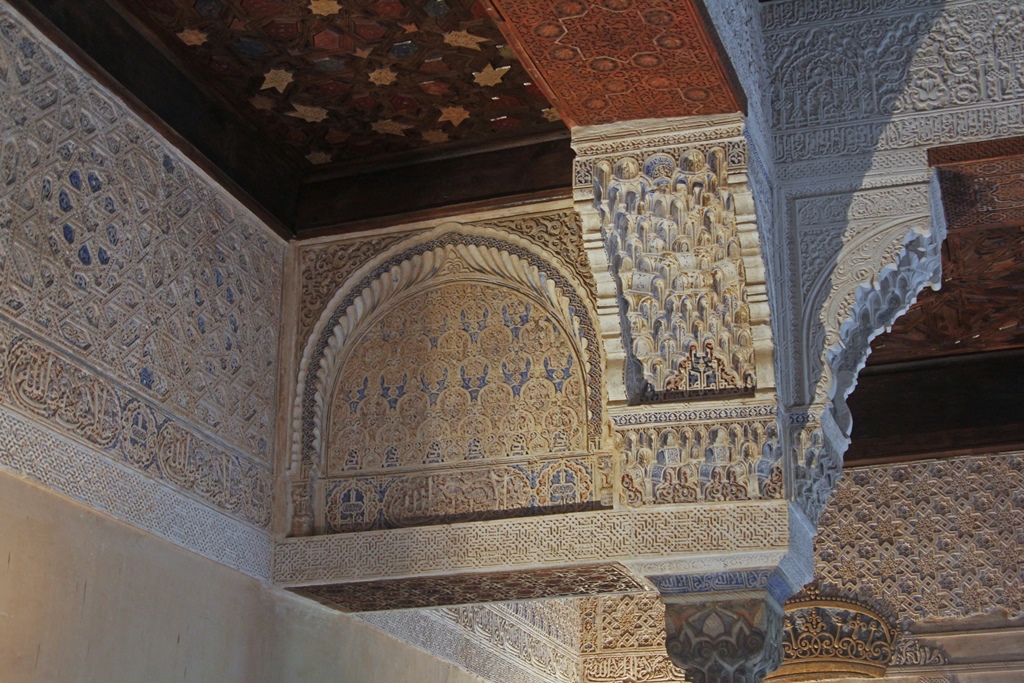
Inside the Mexuar Palace
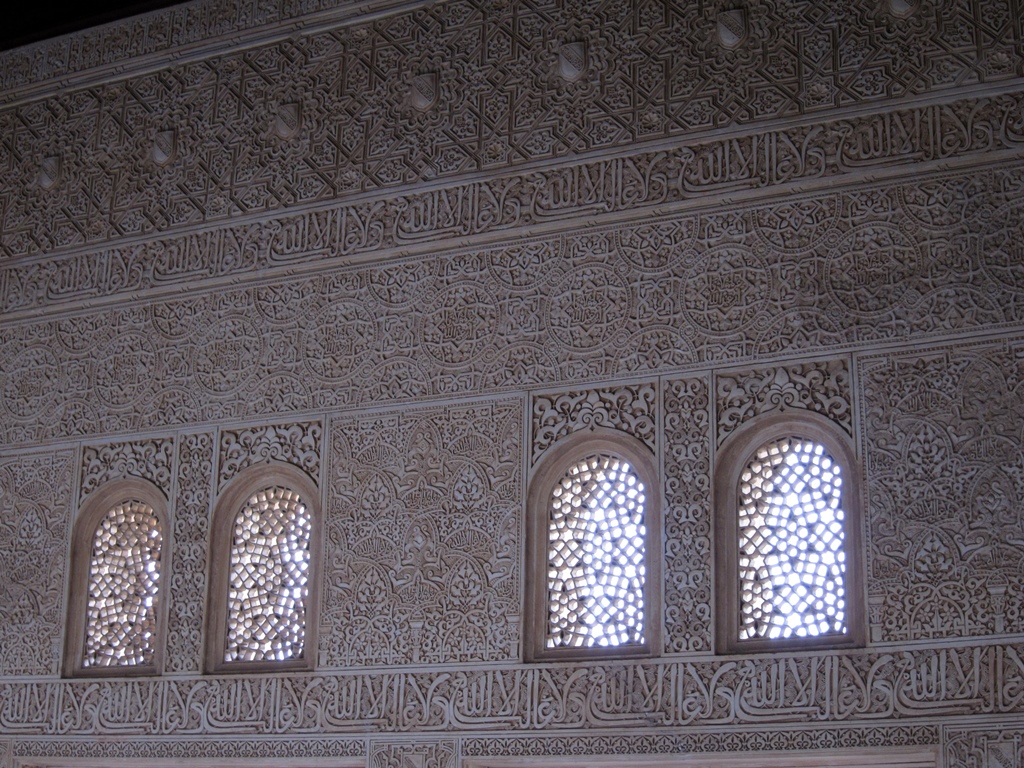
Inside the Mexuar Oratory
Exiting the Mexuar Palace put us in a small courtyard, called the Courtyard of the Mexuar.
At one end of this courtyard was a room called the Golden Chamber, thought to be used by
Moorish officials and secretaries and as a waiting room, and at the other was the entrance
to the next palace, the Comares Palace.
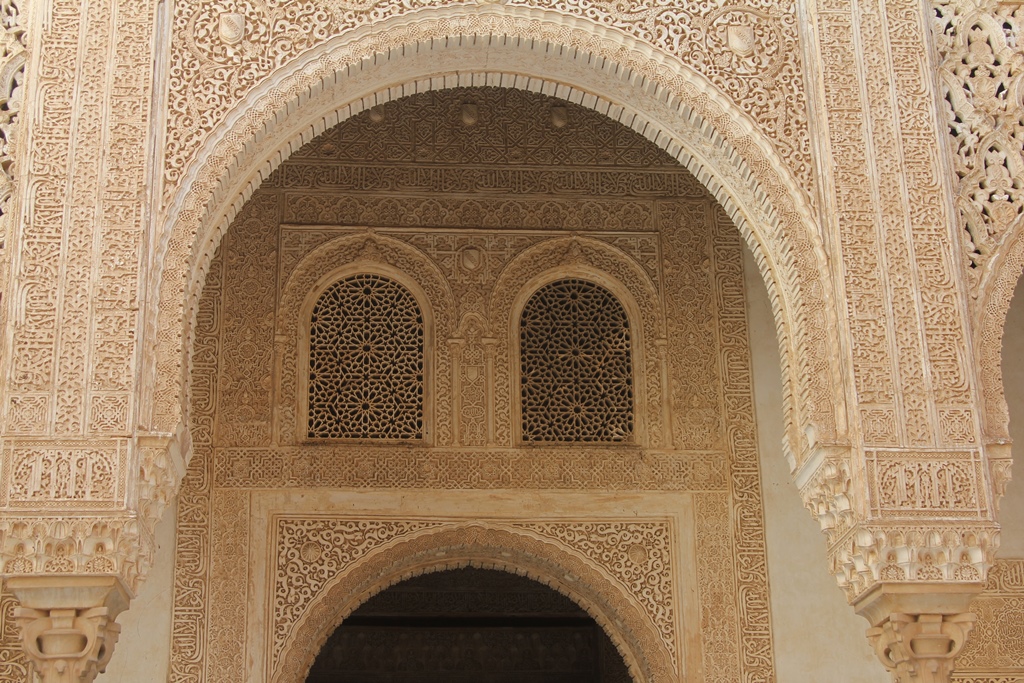
Windows Above Entrance to Golden Chamber
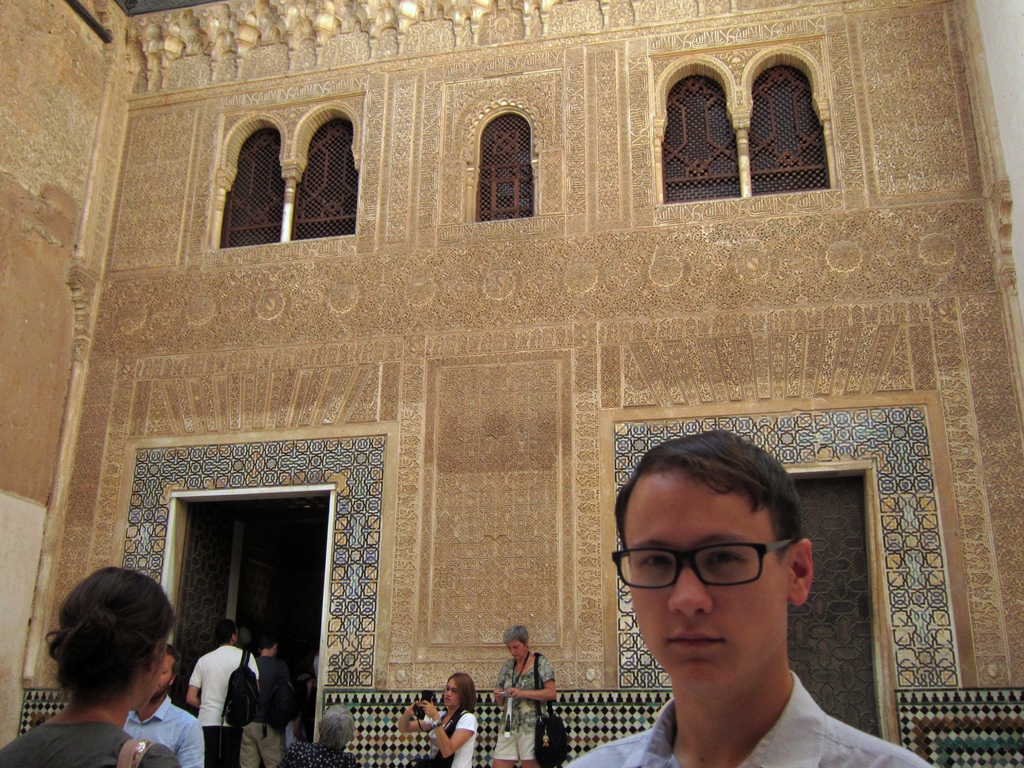
Philip and Comares Palace Entrance
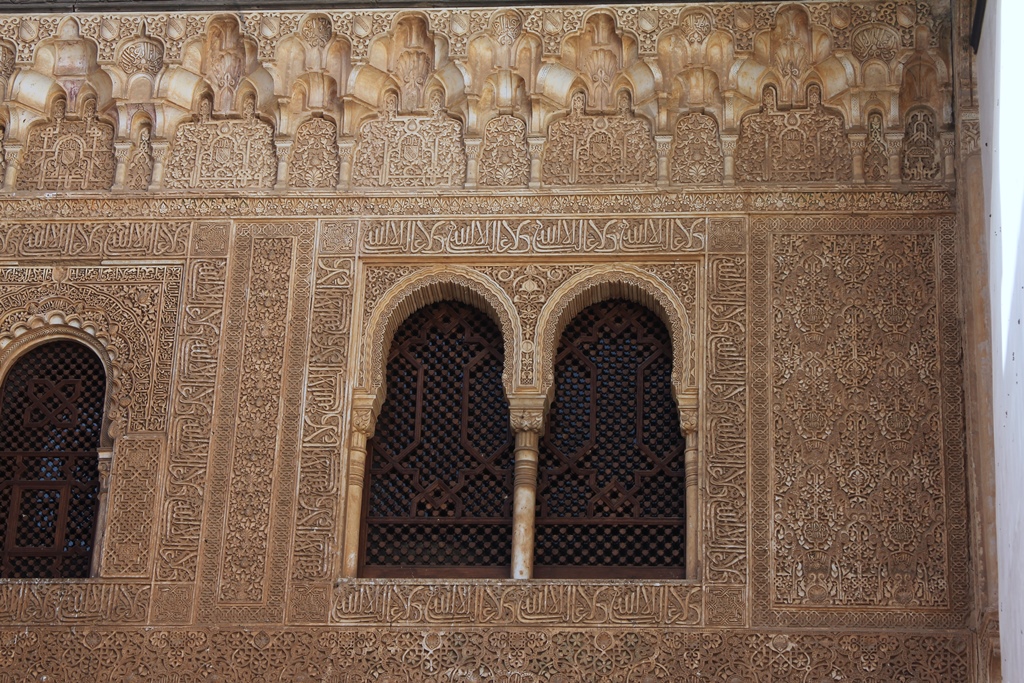
Window Detail, Comares Palace
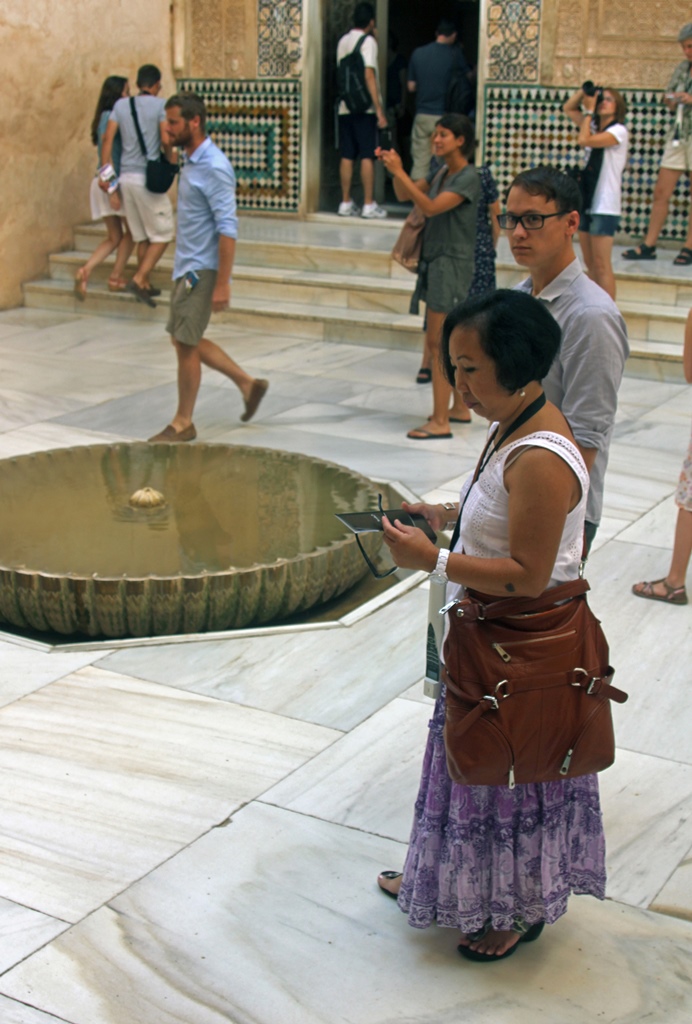
Nella and Philip, Courtyard of the Mexuar
The Comares Palace surrounds a large courtyard, called the Courtyard of the Myrtles. The
courtyard holds a large reflective pool (which also supplies some cooling, through evaporation),
and is bookended by a South Gallery (which held a small and not-too-interesting exhibit), at the
south end, and the Comares Tower, at the north end.
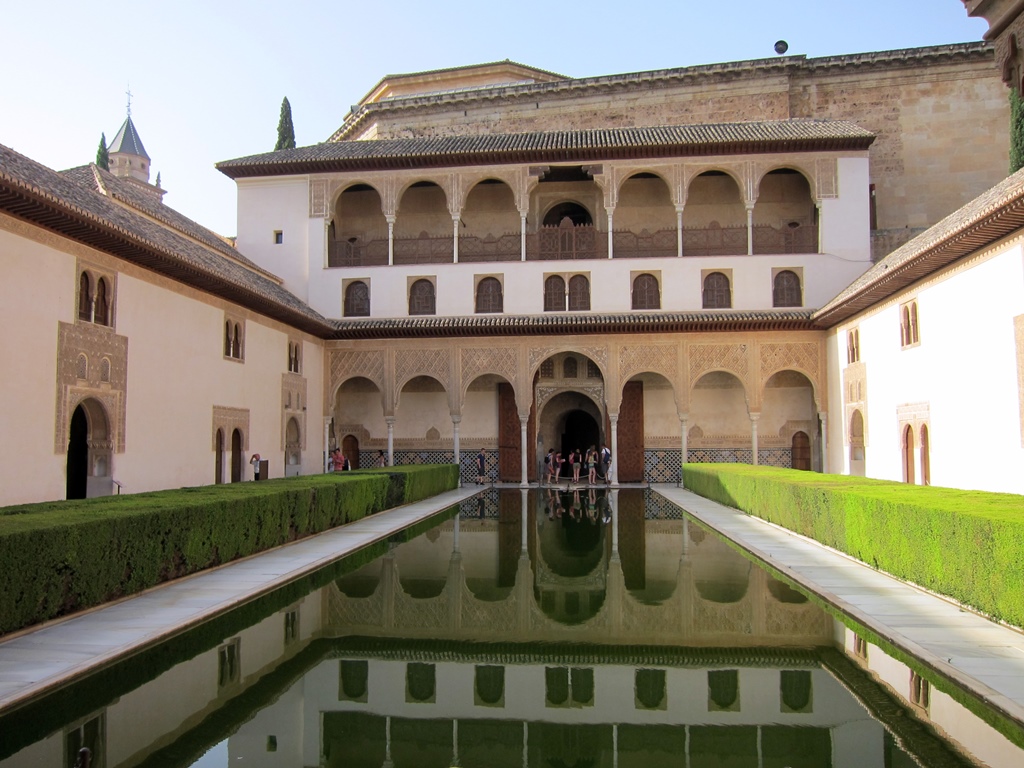
Courtyard of the Myrtles

Courtyard of the Myrtles with South Gallery
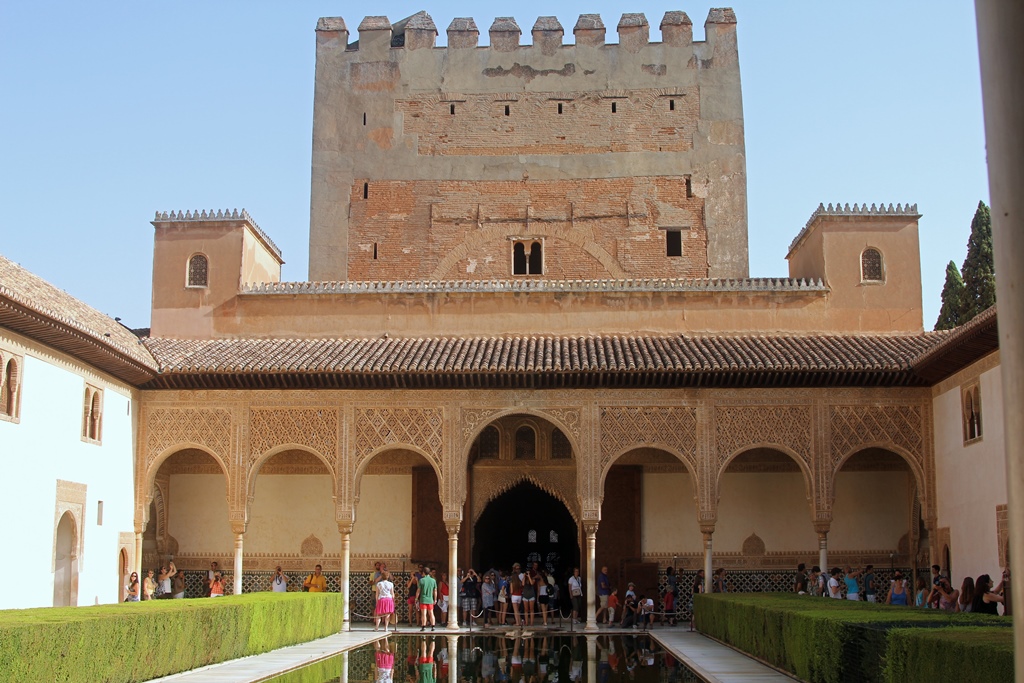
Courtyard of the Myrtles with Comares Tower

Pigeons, Fountain, Comares Tower
Inside the Comares Tower is the largest room in the Alhambra, the Hall of the Ambassadors. This
room is thoroughly decorated, and served as the throne room for the Moorish sultans (and probably
the Christian Monarchs as well).
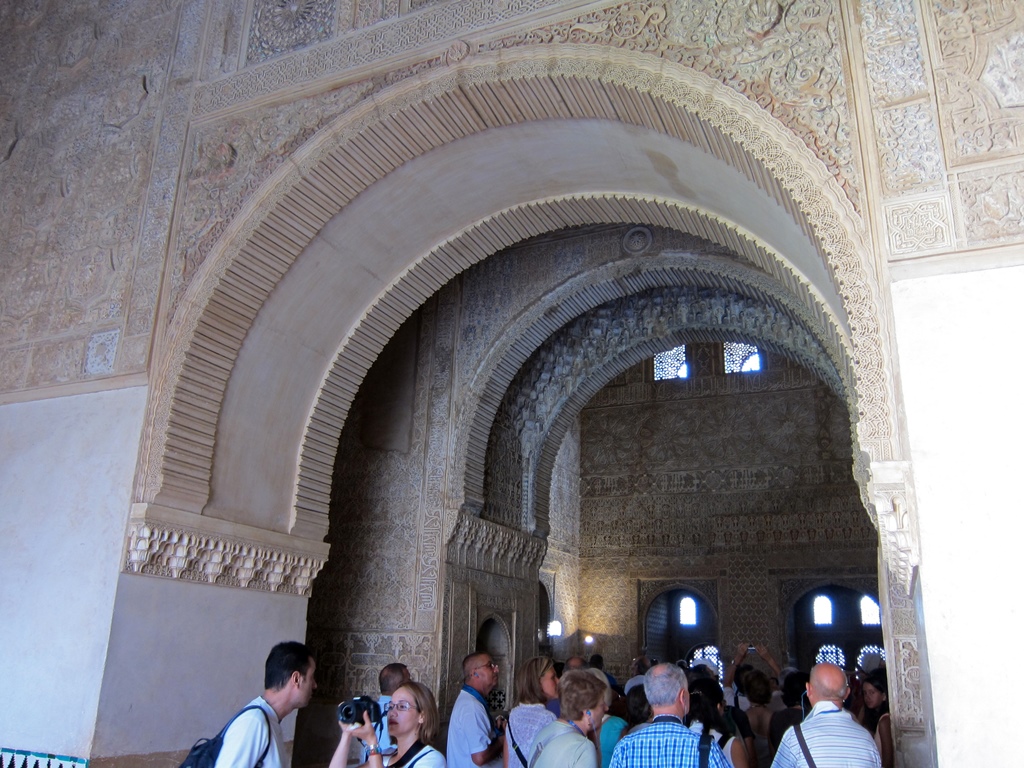
Entrance to Hall of the Ambassadors
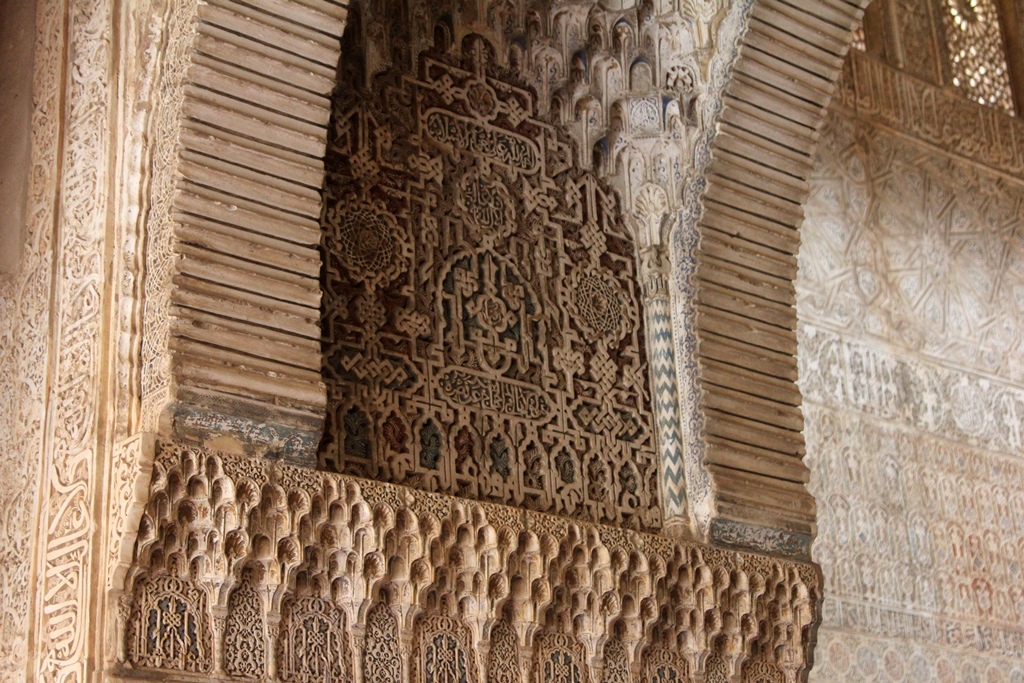
Archway Detail, Hall of the Ambassadors
Inside the Hall of the Ambassadors
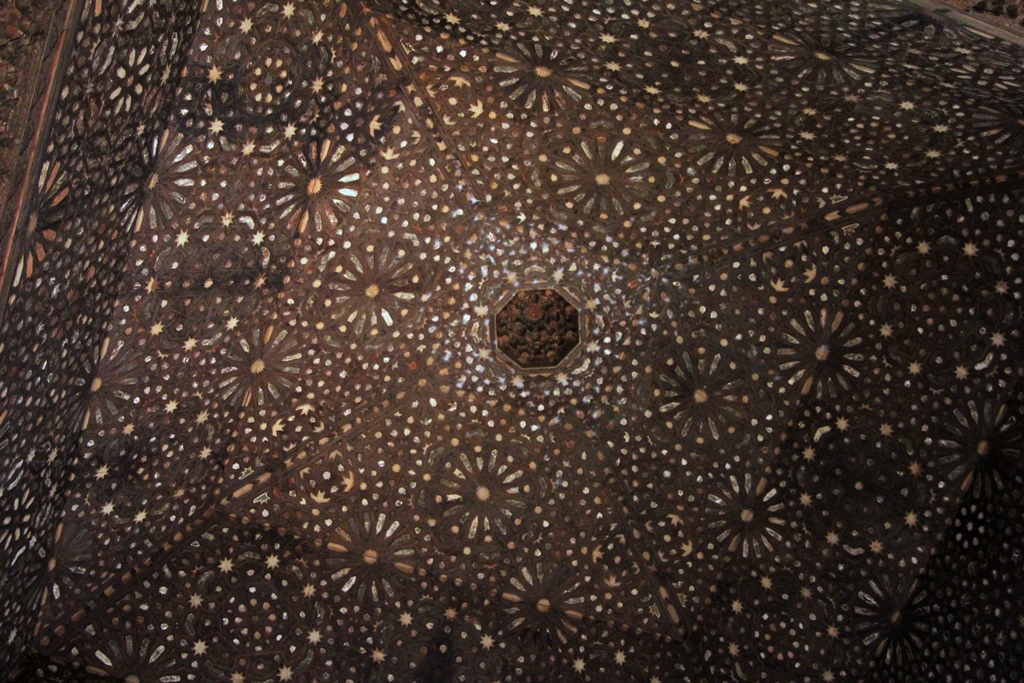
Ceiling, Hall of the Ambassadors
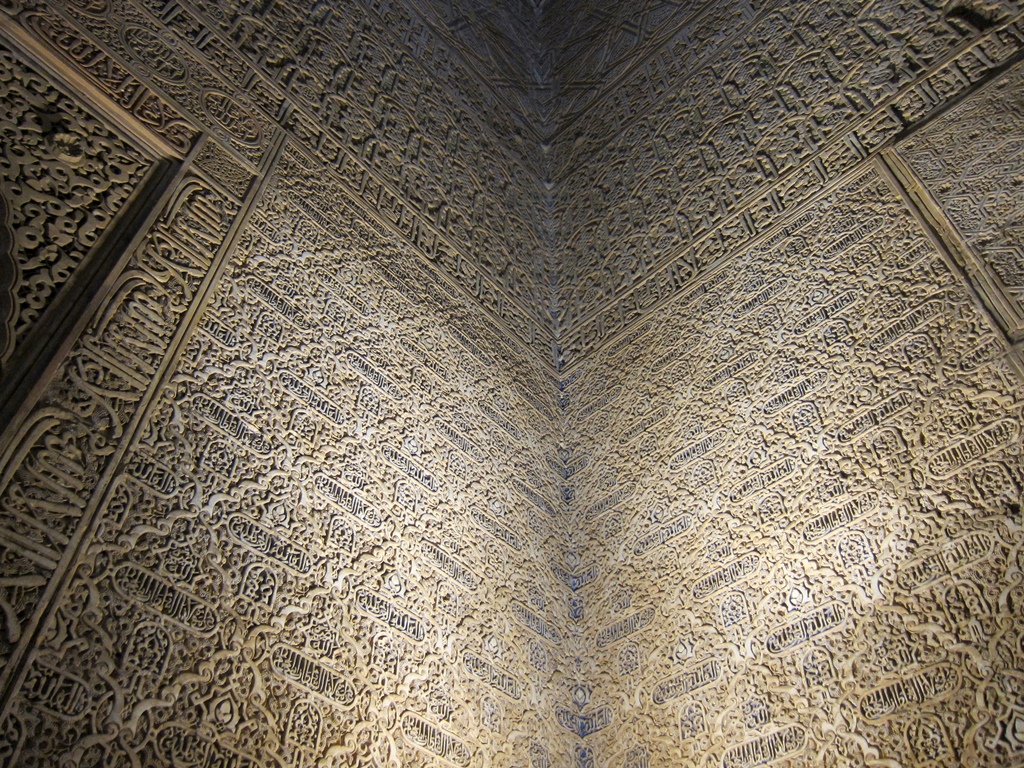
Corner, Hall of the Ambassadors
Exiting the Courtyard of the Myrtles through a side doorway propelled us into another courtyard,
called the Courtyard of the Lions. This courtyard is named for a circular fountain in its
center, which is surrounded by twelve marble lions, each spewing a stream of water outward. On
our previous visit to the Alhambra, we did not see this fountain, as it was undergoing
renovation and was hidden from view. But on this visit it was on full display, looking shiny
and new. This fountain is well known, and is much copied (but never equaled!).
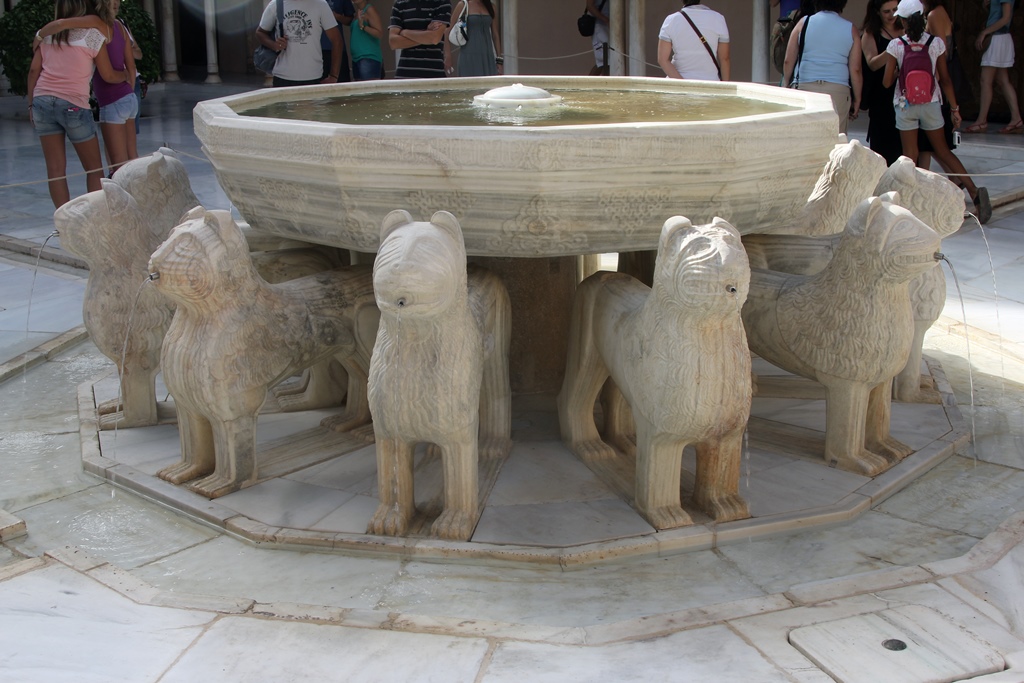
Lion Fountain

Lion Fountain and Courtyard of the Lions
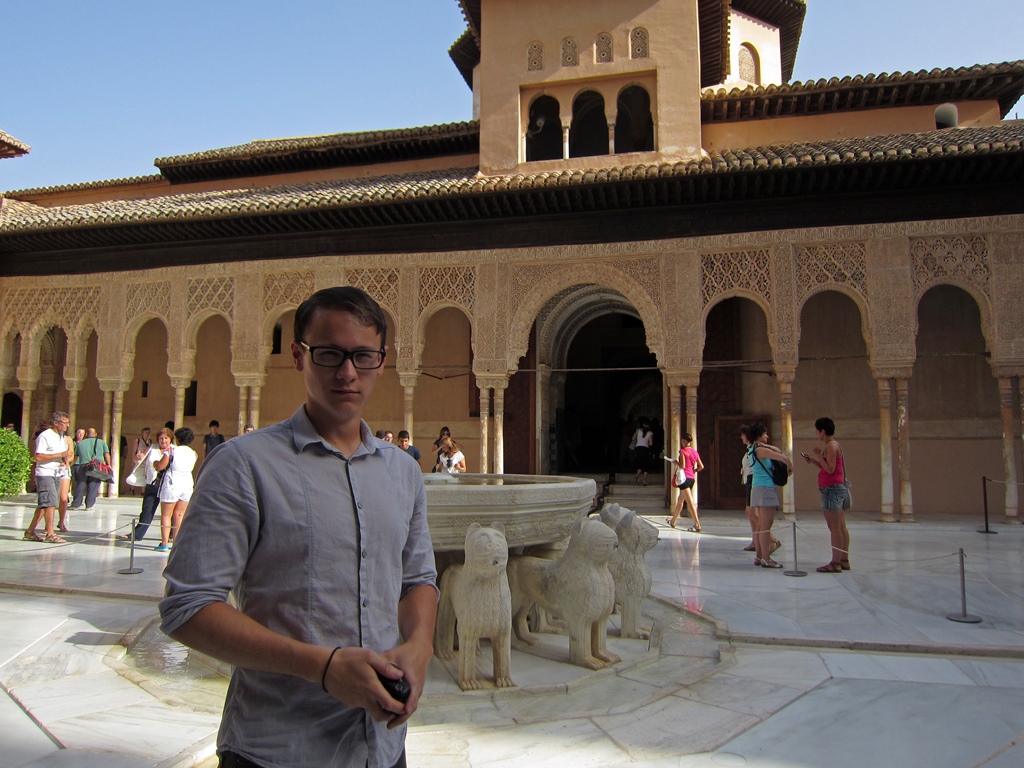
Philip, Courtyard of the Lions
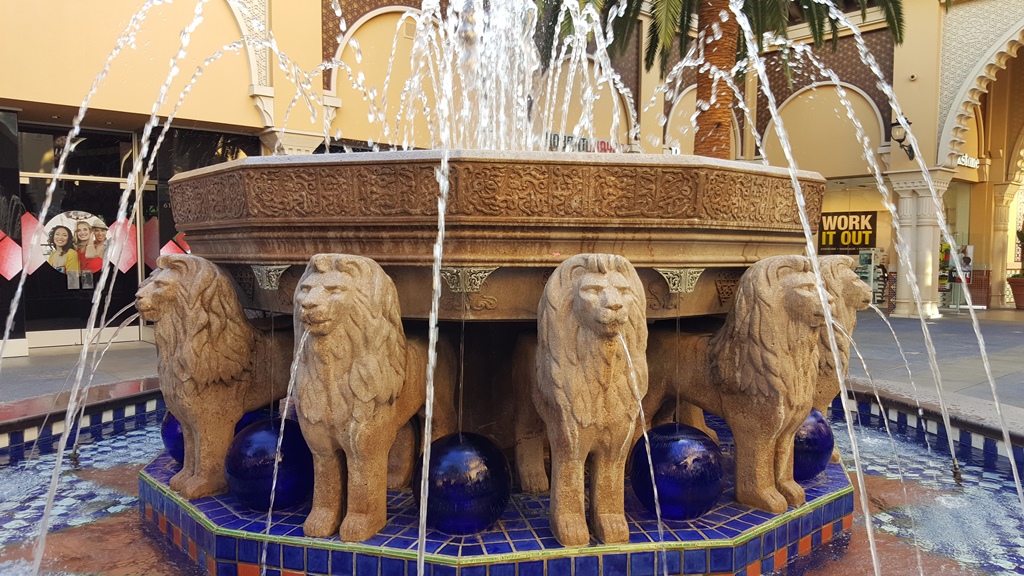
Lion Fountain, Irvine Spectrum Shopping Center
The courtyard is surrounded by galleries and porticoes, with small fountains of their own,
which drain through open channels in the courtyard floor into the base of the lion fountain.
The galleries and porticoes are supported by thin marble columns (apparently there are 124
of them), and there are elaborate tile and stucco decorations everywhere.
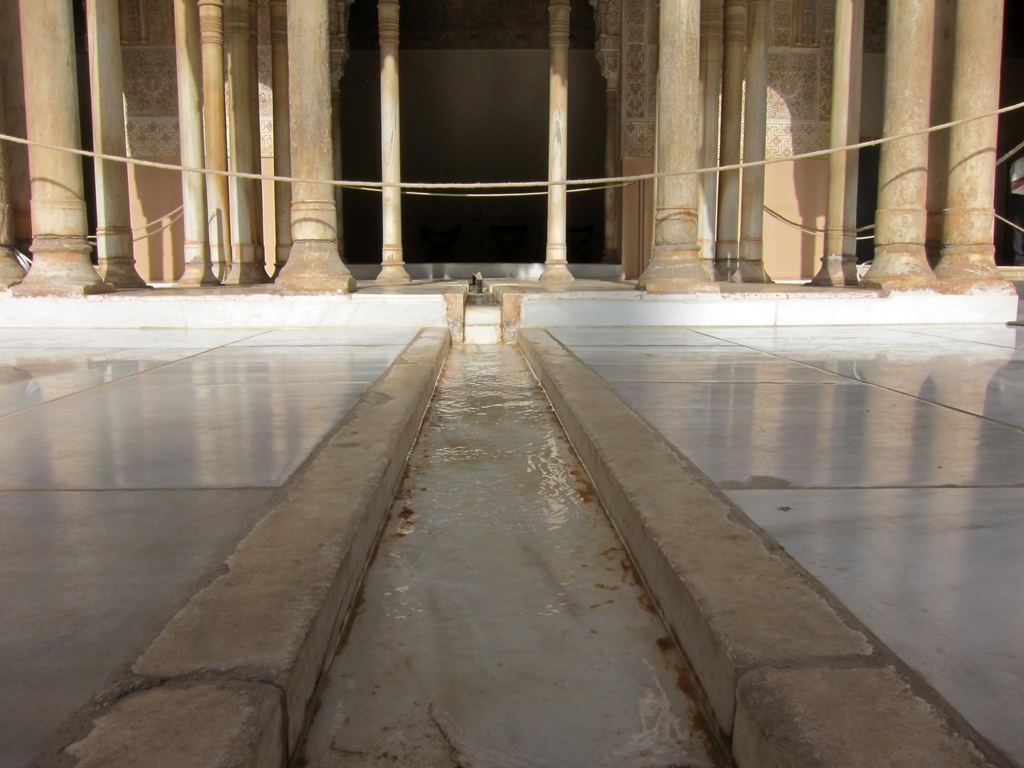
In a Water Channel
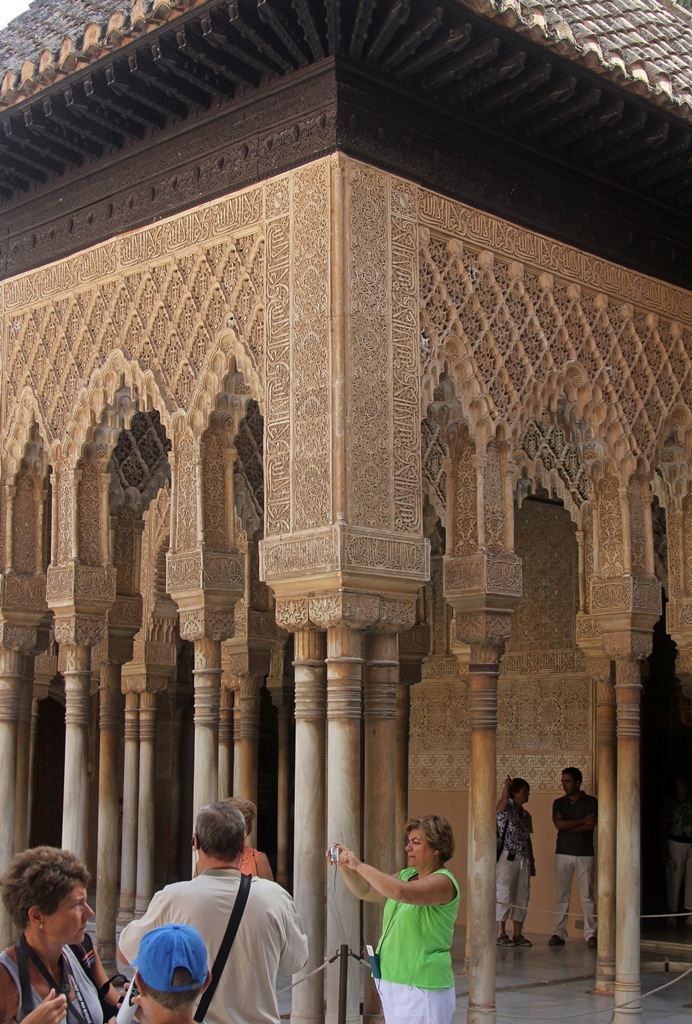
Portico and Tourists, Courtyard of the Lions
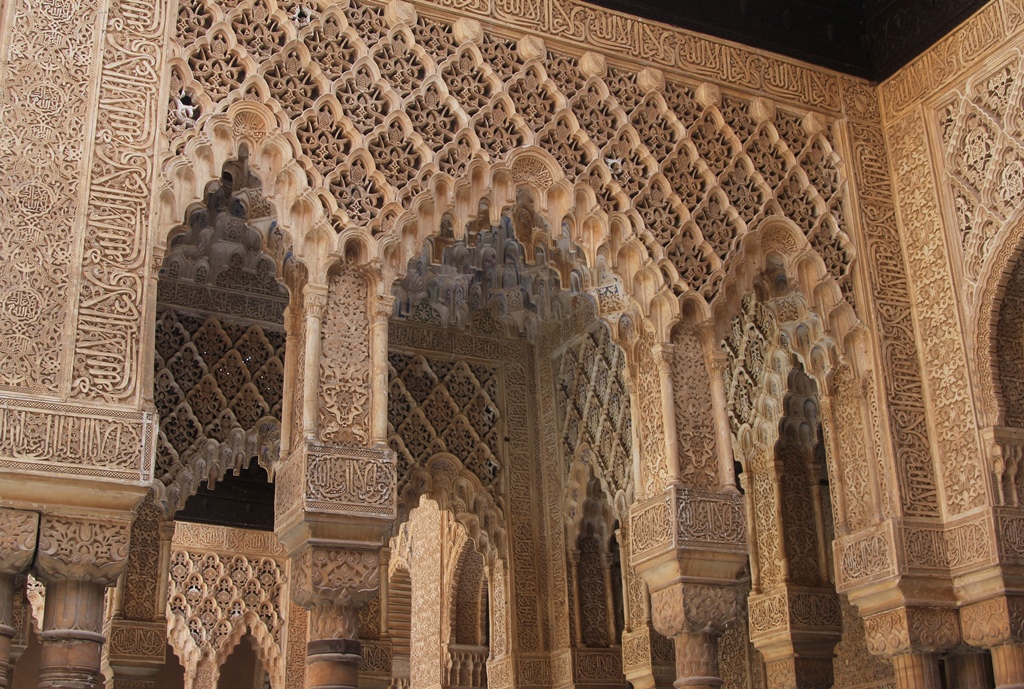
Portico Detail, Courtyard of the Lions
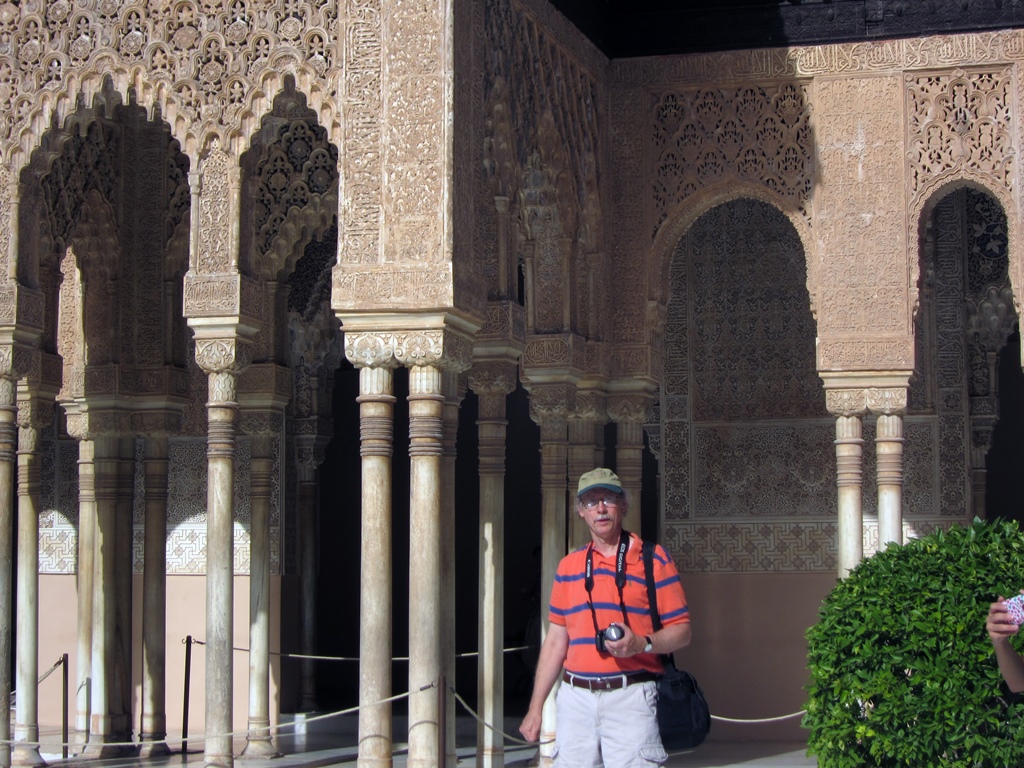
Bob, Courtyard of the Lions
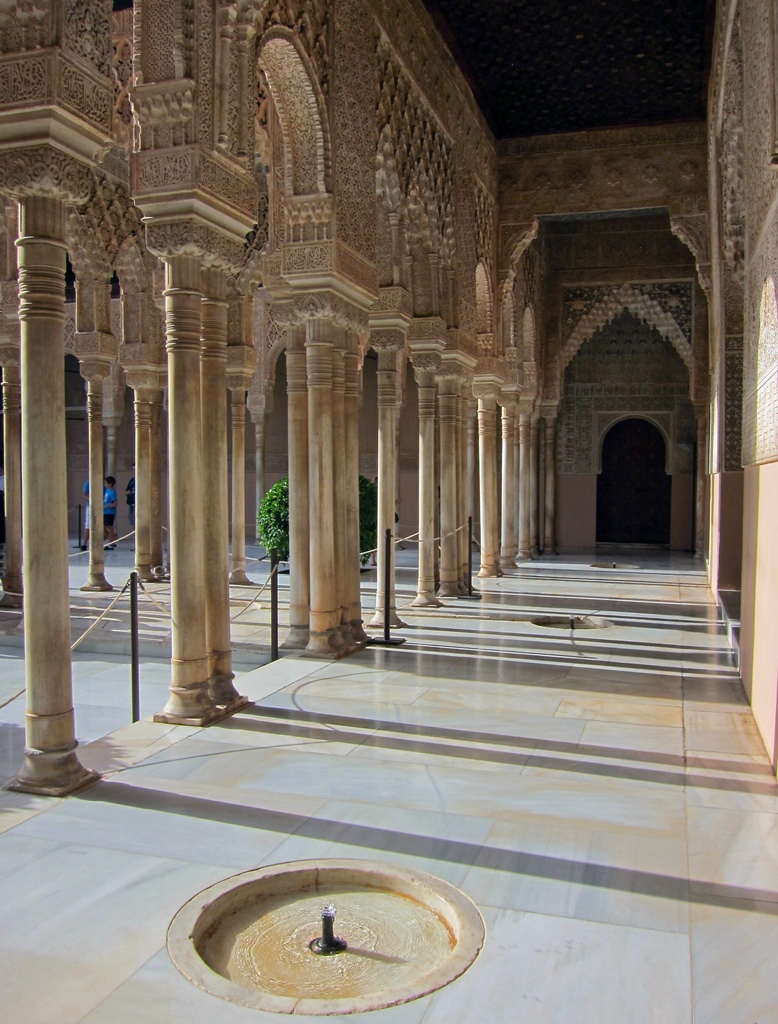
Hallway, Courtyard of the Lions
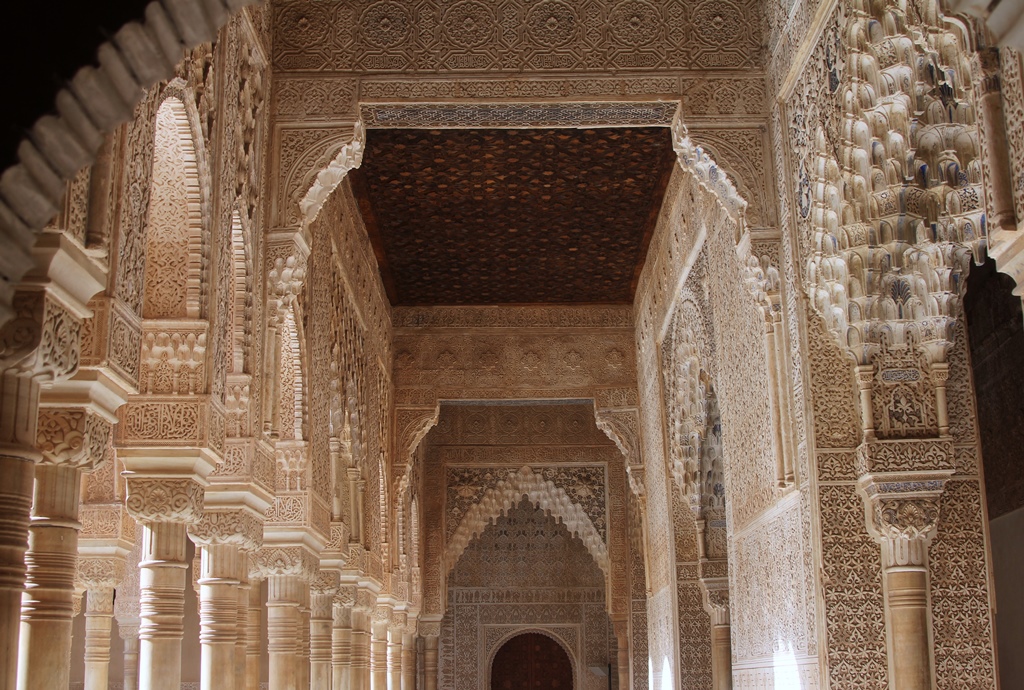
Hallway, Courtyard of the Lions
There are a number of rooms and hallways surrounding the courtyard. One is called the Hall
of the Kings. This area was used for relaxation, and is made up of three main spaces, with
a number of alcoves. The decorations use a stalactite motif.

Hall of Kings
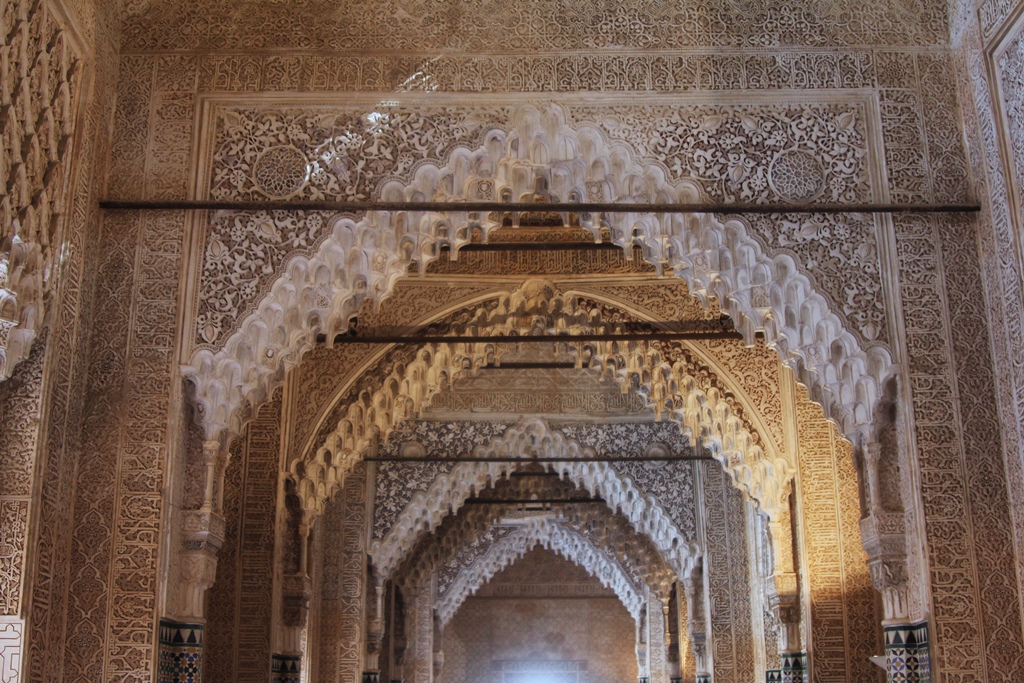
Hall of Kings
Fountains and Water Channel
Another area is called the Hall of the Abencerrages. According to legend, this was the name
of a family that was out of favor with the sultan (the father of Boabdil, to be precise). One
day the family was invited to a banquet in this room, and were surprised by being massacred at
the order of the sultan. In case you were wondering where the Game of Thrones people
get some of their ideas…
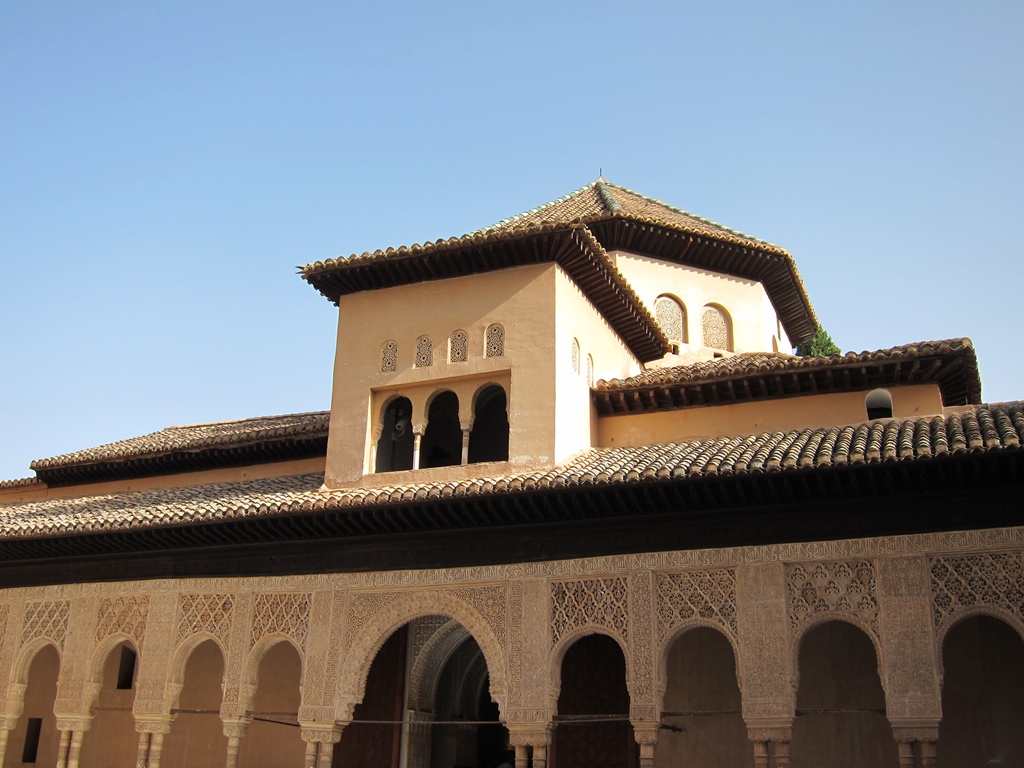
Hall of the Abencerrages, Courtyard of the Lions
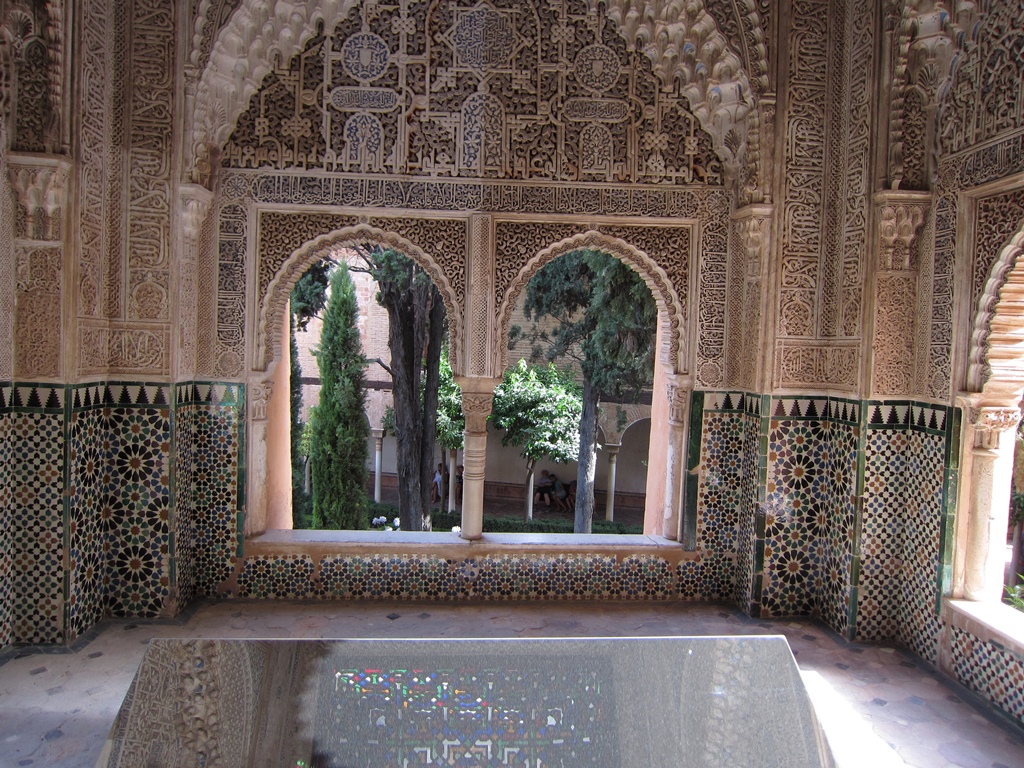
Window, Hall of the Abencerrages
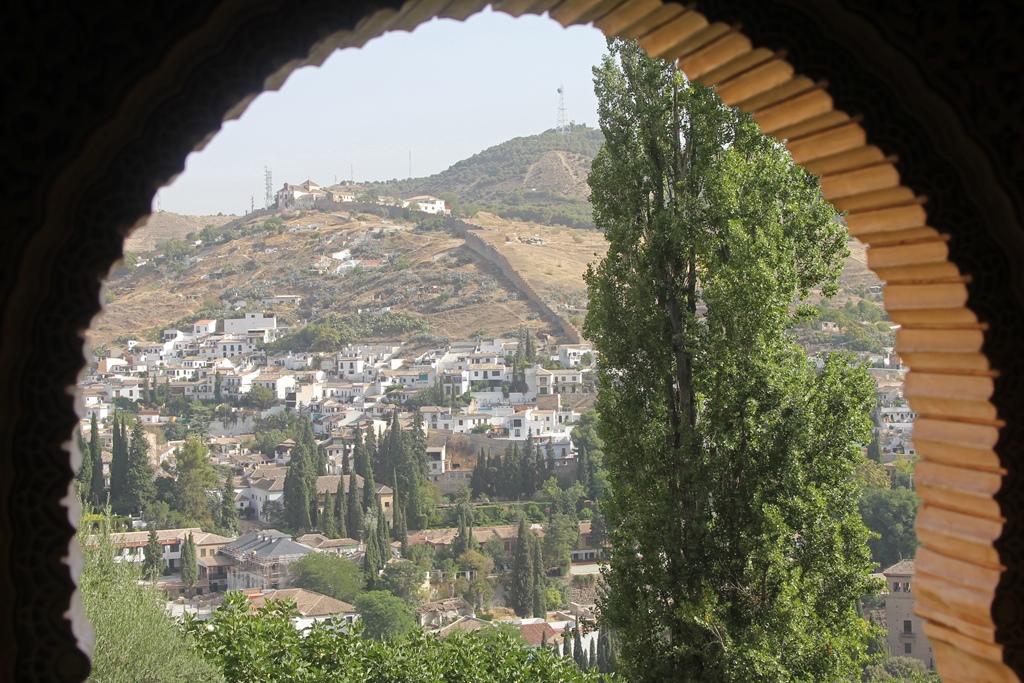
View from Window, Hall of the Abencerrages
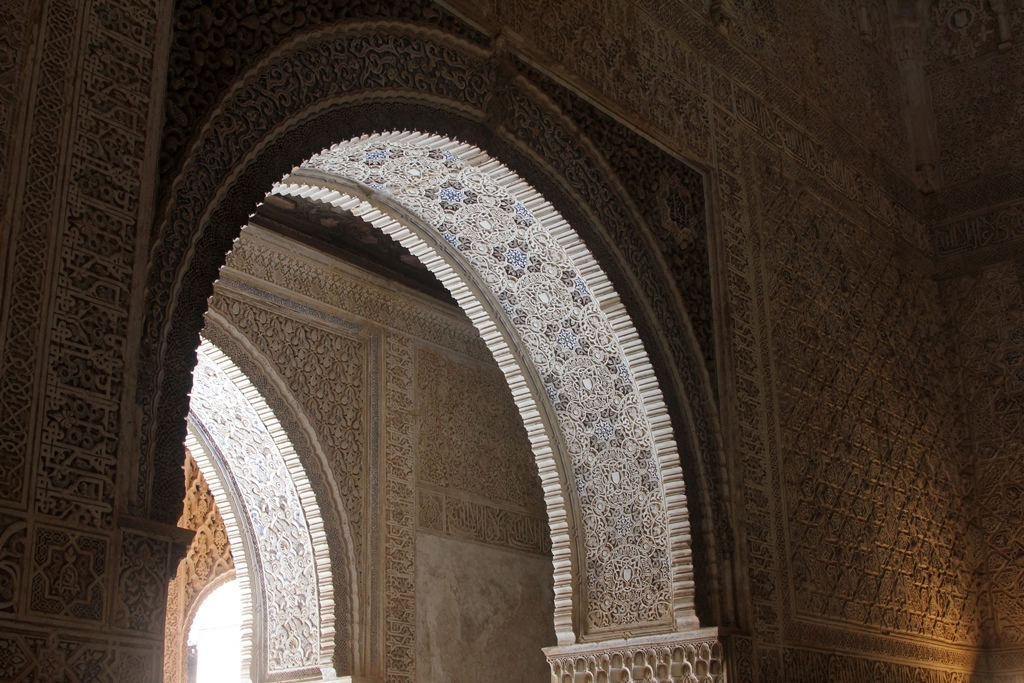
Archway, Hall of the Abencerrages
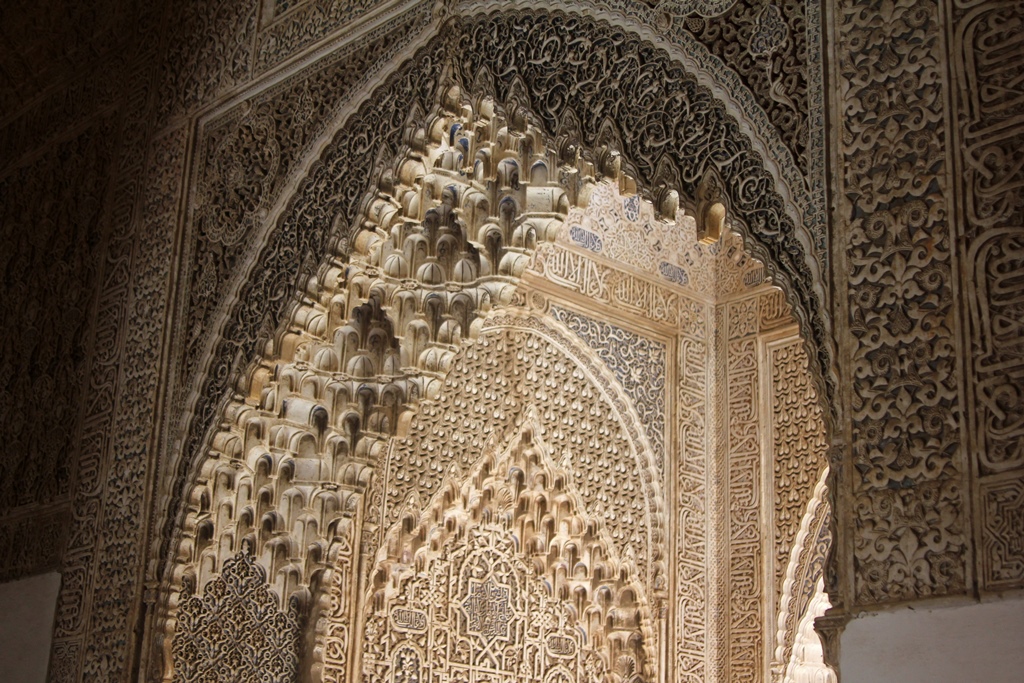
Archway, Hall of the Abencerrages
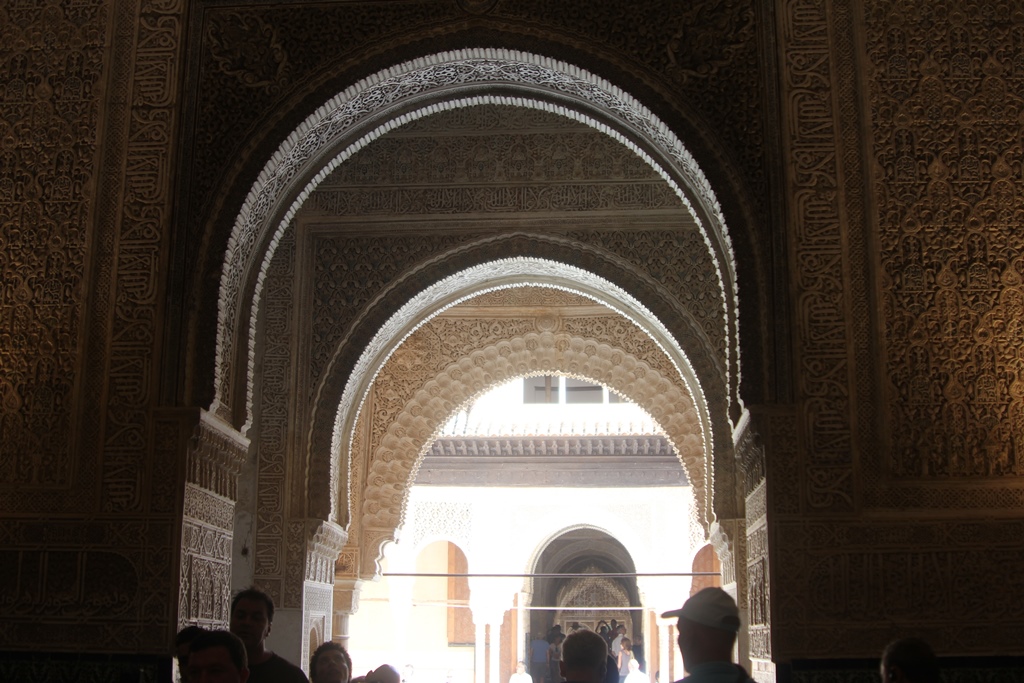
Doorway, Hall of the Abencerrages
The route from the Palace of the Lions led us through some less interesting areas (mostly
shown in our previous Alhambra pages), and eventually to an exit, our palace tour ended. But
there were still some nice gardens to be enjoyed, and some towers, which continued at
intervals along the entire hillside.
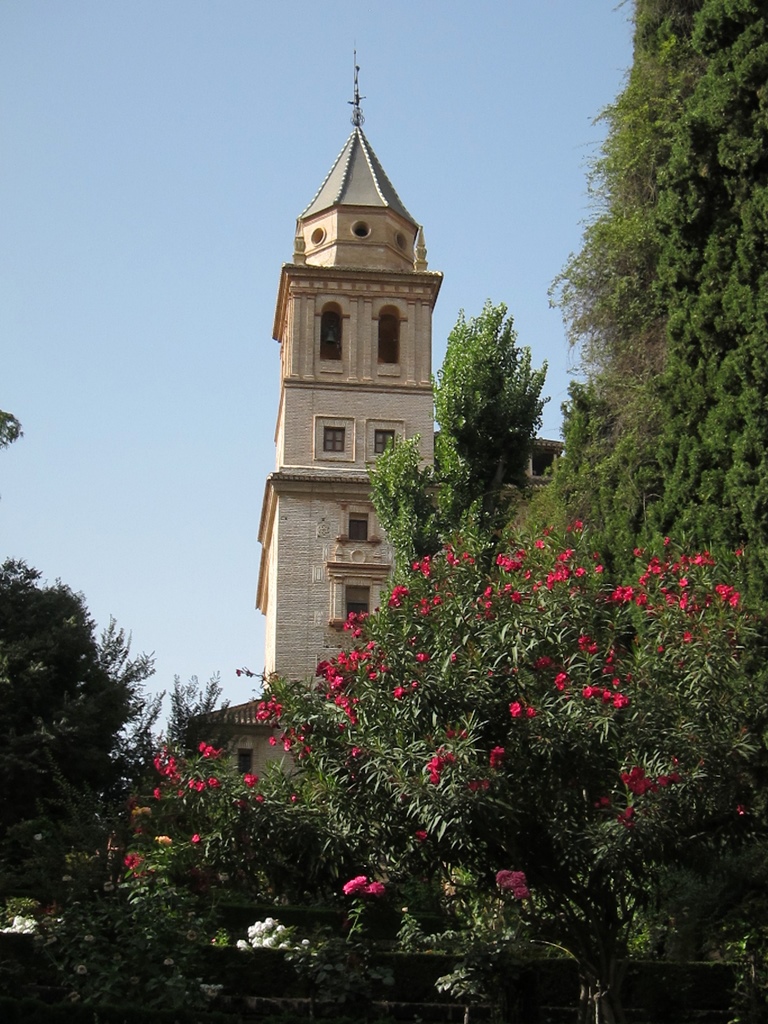
Santa Maria de la Alhambra Church from Garden
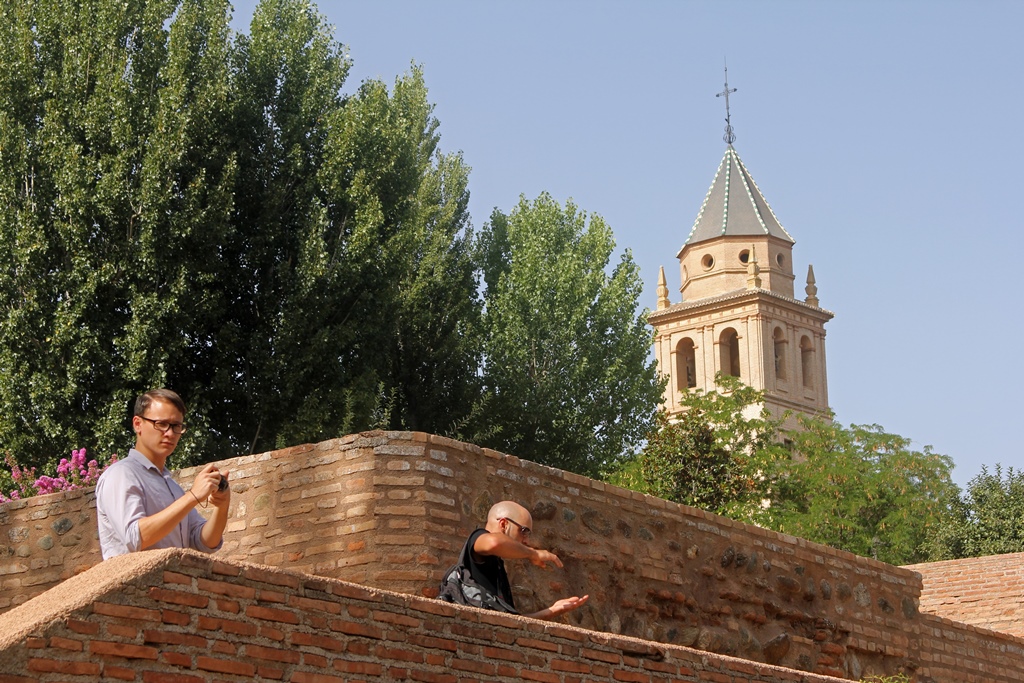
Philip and Santa Maria de la Alhambra Church
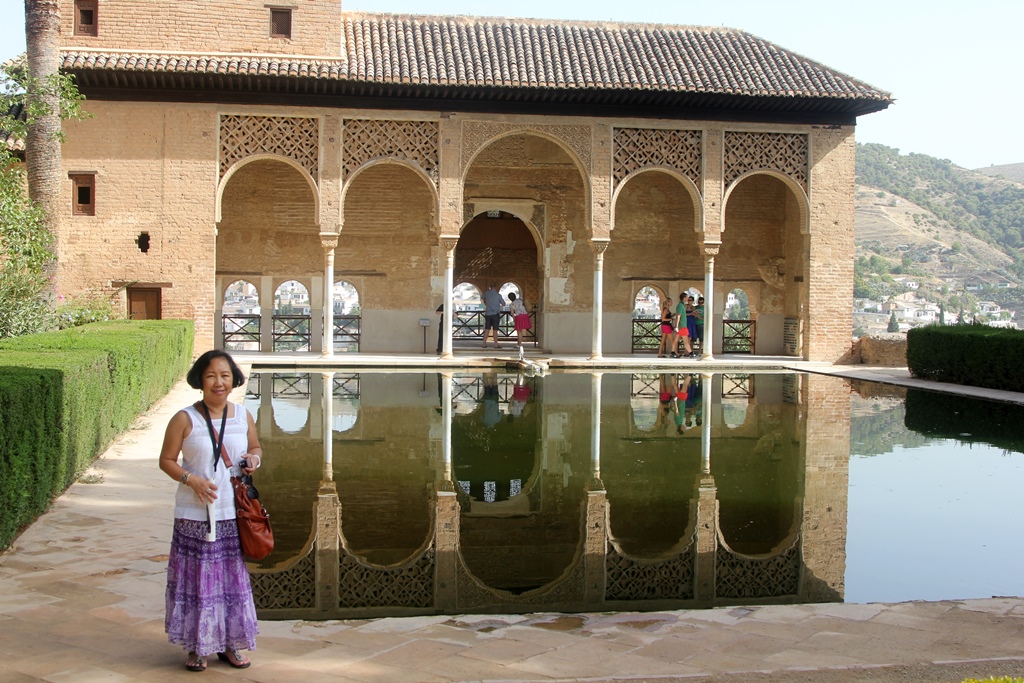
Nella, Tower of the Ladies and Pool
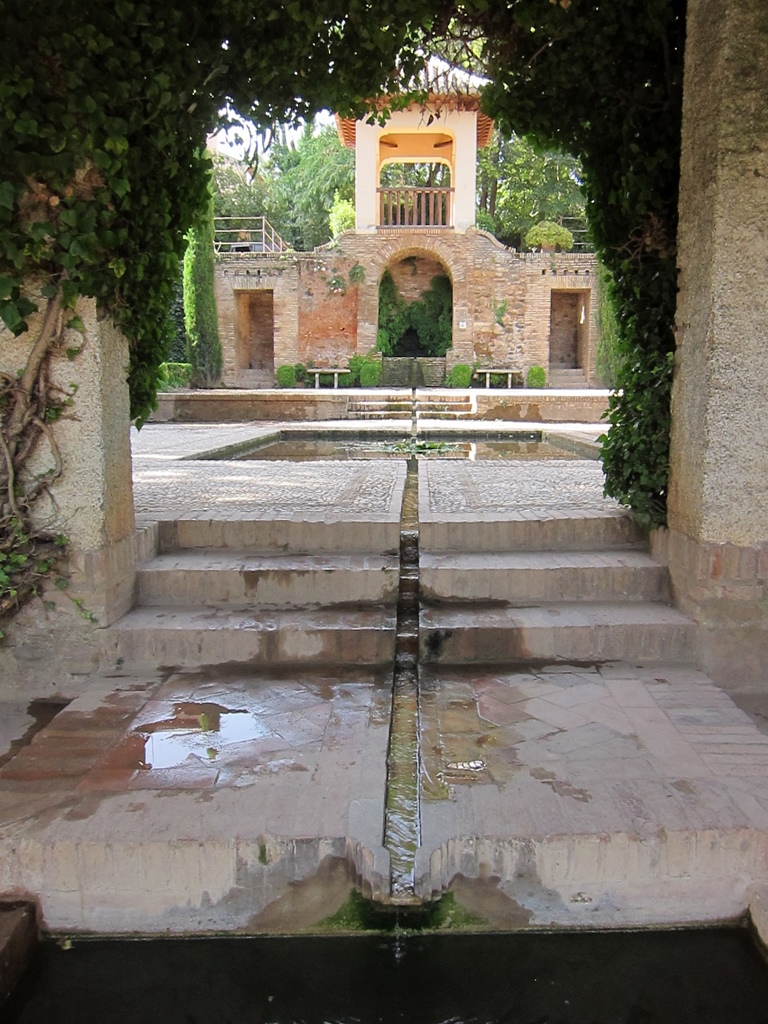
Pool and Water Channel, Garden
Philip and Nella and the Spiked Tower
Following the path through the gardens took us in the general direction of the ticket
office, in which we had no interest. However, shortly before the ticket office there was
a path to the left, leading to a smaller palace/garden complex (included in the price of
admission) called the Generalife. This was our next destination.



























